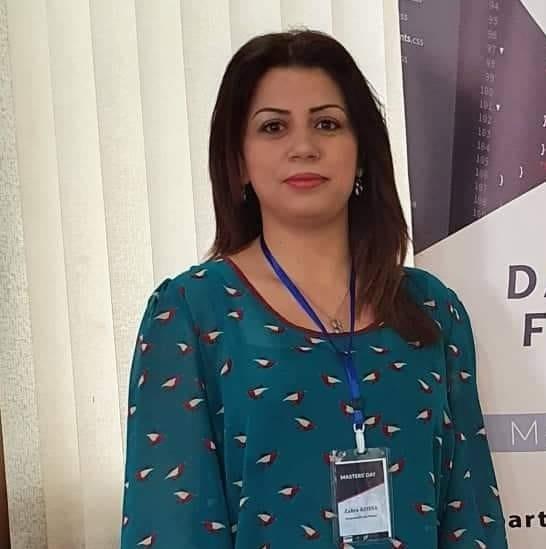Aucune description disponible pour cet axe de recherche.
Description
Membres
Publications
-
2025Hajer Alaya, Lilia Rejeb, Lamjed Ben Said
Explanable AI in automatic sleep scoring: A review
Hajer ALAYA, Lilia Rejeb, Lamjed Ben Said, “Explainable AI in automatic sleep scoring: A review”, International Conference on Intelligence in Business and Industry 2025 (IBI'25) 24 et 25 avril 2025., 2025
Résumé
The application of Artificial Intelligence (AI) in
automatic sleep scoring presents significant opportunities for
enhancing sleep analysis and diagnosing sleep disorders.
However, a major challenge lies in the lack of transparency in
AI-driven decision-making, which can hinder trust and
comprehension among sleep researchers and clinicians.
Explainable Artificial Intelligence (XAI) has emerged as a key
approach to addresss these concerns by providing insights into
AI model predictions and improving interpretability. This
review examines the role and effectiveness of Explainability and
interpretability in automatic sleep scoring, analyzing key
challenges, the impact of various methodologies, and commonly
used algorithms. Based on a comprehensive analysis of 100
recent studies, we bridge the gap between computer-readable
data encodings and human-understandable information,
enhancing model explainability and transparency. Ultimately,
this review underscores the vital role of Explainability in
refining sleep evaluation and decision-making, emphasizing the
necessity of further research to address existing challenges and
maximize its potential.Ali Abdelghafour Bejaoui, Meriam Jemel, Nadia Ben AzzounaExplainable AI Planning:literature review
Automated planning systems have become indispensable tools in a wide range of applications, from robotics and healthcare to logistics and autonomous systems. However, as these systems grow in complexity, their decision-making processes often become opaque, 2025
Résumé
Explainable AI Planning (XAIP) is a pivotal research
area focused on enhancing the transparency, interpretability,
and trustworthiness of automated planning systems. This
paper provides a comprehensive review of XAIP, emphasizing key
techniques for plan explanation, such as contrastive explanations,
hierarchical decomposition, and argumentative reasoning frameworks.
We explore the critical role of argumentation in justifying
planning decisions and address the challenges of replanning in
dynamic and uncertain environments, particularly in high-stakes
domains like healthcare, autonomous systems, and logistics.
Additionally, we discuss the ethical and practical implications
of deploying XAIP, highlighting the importance of human-AI
collaboration, regulatory compliance, and uncertainty handling.
By examining these aspects, this paper aims to provide a detailed
understanding of how XAIP can improve the transparency,
interpretability, and usability of AI planning systems across
various domains.Boutheina JLIFI, Syrine Ferjani, Claude DuvalletA Genetic Algorithm based Three HyperParameter optimization of Deep Long Short Term Memory (GA3P-DLSTM) for Predicting Electric Vehicles energy consumption
Computers and Electrical Engineering, 123, 110185., 2025
Résumé
To overcome Climate Change, countries are turning to greener transportation systems. Therefore, the use of Electric Vehicles (EVs) is leveraging substantially since they present multiple advantages, like reducing hazardous emissions. Recently, the demand for EVs has increased, which means that more charging stations need to be available. By the year 2030, 15 million EVs will be accessible, and since the number of charging stations is limited, the charging needs should be defined for better management of the charging infrastructure. In this research, we aim to tackle this problem by efficiently predicting the energy consumption of EVs. We proposed a Genetic Algorithm (GA) based Three HyperParameter optimization of Deep Long Short Term Memory (GA3P-DLSTM), which is an optimized LSTM model that incorporates a GA for Hyperparameter Tuning. After experimenting our methodology and performing a comparative analysis with previous studies from the literature, the obtained results showed the efficiency of our novel model, with Mean Squared Error (MSE) equals to 0.000112 and a Determination Coefficient (R) equals to 0.96470. It outperformed other models of the literature for predicting energy use based on real-world data collected from the campus of Georgia Tech in Atlanta, USA.
Jihene LATRECH, Zahra Kodia, Nadia Ben AzzounaCoD-MaF: toward a Context-Driven Collaborative Filtering using Contextual Biased Matrix Factorization
International Journal of Data Science and Analytics, 1-18., 2025
Résumé
Contextual recommendation has become attainable through the massive amounts of contextual information generated by smartphones and Internet of Things (IoT) devices. The availability of a huge amount of contextual data paves the way for a revolution in recommendation systems. It overcomes the static nature of personalization, which does not allow the discovery of new items and interests, toward a contextualization of the user’s tastes, which are in constant evolution. In this paper, we proposed CoD-MaF, a Context-Driven Collaborative Filtering using Contextual biased Matrix Factorization. Our approach employs feature selection methods to extract the most influential contextual features that will be used to cluster the users using K-means algorithm. The model then performs a collaborative filtering based on matrix factorization with improved contextual biases to suggest relevant personalized recommendations. We highlighted the performance of our method through experiments on four datasets (LDOS-CoMoDa, STS-Travel, IncarMusic and Frappe). Our model enhanced the accuracy of predictions and achieved competitive performance compared to baseline methods in metrics of RMSE and MAE.
Jihene LATRECH, Zahra Kodia, Nadia Ben AzzounaMachine Learning Based Collaborative Filtering Using Jensen-Shannon Divergence for Context-Driven Recommendations
In Proceedings of the 17th International Conference on Agents and Artificial Intelligence (ICAART 2025) - Volume 3, pages 419-426, 2025
Résumé
This research presents a machine learning-based context-driven collaborative filtering approach with three
steps: contextual clustering, weighted similarity assessment, and collaborative filtering. User data is clustered
across 3 aspects, and similarity scores are calculated, dynamically weighted, and aggregated into a normalized
User-User similarity matrix. Collaborative filtering is then applied to generate contextual recommendations.
Experiments on the LDOS-CoMoDa dataset demonstrated good performance, with RMSE and MAE rates of
0.5774 and 0.3333 respectively, outperforming reference approaches.Fatma Dhaoui, Kalthoum Rezgui, Nadia Ben AzzounaExplaining MOOC Dropout Prediction Using ML and DL Models: An Empirical Study on the KDDCup 2015 Dataset
L’étude vise à prédire les abandons dans les MOOCs en comparant des modèles d’apprentissage automatique (ML) et d’apprentissage profond (DL), tout en intégrant des techniques d’explicabilité (XAI) pour comprendre les comportements des apprenants., 2025
Résumé
Massive Open Online Courses (MOOCs) face high
dropout rates, often exceeding 80%, undermining their educational
potential. This study presents a comparative evaluation
of Machine Learning (ML) and Deep Learning (DL) models for
early dropout prediction using the KDDCup2015 dataset, with a
dual focus on predictive performance and model interpretability
through eXplainable AI (XAI) techniques. Among traditional
ML models, the Decision Tree (DT) achieves the highest
performance (90.18% AUC-PR by Week 4), outperforming
Logistic Regression (LR) and Support Vector Machine (SVM).
In the ensemble category, AdaBoost leads with 90.35% AUCPR.
The hybrid CNN-LSTM outperforms standalone CNN and
LSTM models, reaching up to 93,76% AUC-PR. XAI analysis
reveals that frequent platform access, navigation patterns and
problem solving activities are key predictors of dropout. These
insights support early interpretable interventions to improve
learner retention while maintaining model transparency. -
2024Alia Maaloul, Meriam Jemel, Nadia Ben Azzouna
Feature selection for Gestational Diabetes Mellitus prediction using XAI based AutoML approach
International Conference on Decision Aid and Artificial Intelligence 2024 (ICODAI), Tunis, Tunisia, 2024, 2024
Résumé
Predicting Gestational Diabetes Mellitus (GDM) is crucial for
pregnant women to enable regular monitoring of their blood sugar levels and
adherence to a healthy diet. Early intervention can significantly lower the risk
of developing this condition. To assess this risk, Machine Learning (ML) and
Deep Learning techniques are employed. However, traditional ML models often
face challenges in accurately predicting GDM risk due to the complex
processing required to optimize their hyperparameters for the best performance.
This study presents a feature selection for GDM prediction using AutoML-XAI
techniques (Automatic Machine Learning – eXplainable Artificial Intelligence
techniques) approach, which aims to automatically predict GDM risk as
accurate as possible while providing meaningful interpretations of the
predictive results used in feature selection. The AutoML models generated
utilize a Kaggle dataset and several combinations of features selected based on
their scores of importance determinated with XAI techniques such as SHAP(Shapley Additive Explanations) and LIME (Local Interpretable Model-
agnostic Explanations). The proposed approach of autoML and featuresselection with XAI techniques leads to the creation of a precise, efficient, and
easily interpretable model which surpasses other machine learning models in
predicting GDM risk without the need for human intervention. The scores of
importance of features are involved in the feature selection process and
multiple AutoML models are generated and assessed, with the optimal AutoML
model being established automatically.Zakia Zouaghia, Zahra Kodia, Lamjed Ben SaidA novel AutoCNN model for stock market index prediction
Journal of Telecommunications and the Digital Economy, 12(1), 612-636., 2024
Résumé
Stock markets have an important impact on economic growth of countries. The prediction
of stock market indexes has been a complex task for last years. Indeed, many researches and financial analysts are highly interested in the research area of stock market prediction. In this paper, we propose a novel framework, titled AutoCNN based on artificial intelligence techniques, to predict future stock market indexes. AutoCNN is composed mainly of three stages: (1) CNN for Automatic Feature Extraction, (2) The Halving Grid Search algorithm is combined to CNN model for stock indexes prediction and (3) Evaluation and recommendation. To validate our AutoCNN, we conduct experiments on two financial datasets that are extracted in the period between 2018 and 2023, which includes several events such as economic, health and geopolitical international crises. The performance of AutoCNN model is quantified using various metrics. It is benchmarked against different models and it proves strong prediction abilities. AutoCNN contributes to emerging technologies and innovation in the financial sector by automating decision-making, leveraging advanced pattern recognition, and enhancing the overall decision support system for investors in the digital economy.Zakia Zouaghia, Zahra Kodia, Lamjed Ben SaidPredicting the stock market prices using a machine learning-based framework during crisis periods
Multimed Tools Appl 84, 28873–28907., 2024
Résumé
Stock markets are highly volatile, complex, non-linear, and stochastic. Therefore, predicting stock market behavior is one of finance’s most complex challenges. Recently, political, health, and economic crises have profoundly impacted global stock prices, leading researchers to use machine learning to predict prices and analyze financial data. This article delves into two primary facets: firstly, examining stock price responses to the Russia-Ukraine war and the COVID-19 pandemic by assessing volatility and draw-downs from 2018 to 2023. Secondly, we introduce a framework named StockPredCris, designed to predict future stock indices employing two machine learning algorithms: Support Vector Regression (SVR) and eXtreme Gradient Boosting (XGBoost). Our experiments are conducted on four major stock market indices (NASDAQ, Russell 2000, DAX, and SSE) using a combination of historical stock index data and COVID-19 pandemic data. The performance of the implemented models is evaluated using five regression metrics along with the CPU time metric. The results of SVR demonstrates superior performance and signifcantly outperforms the other considered models for benchmarking. For instance, SVR achieved 0.0 MSE and 99.99% R for the four stock indices, with training times between 0.005 and 0.007 seconds. We recommend SVR for predicting future stock prices during crises. This study offers valuable insights for financial decision-makers, guiding them in making informed choices by understanding stock market reactions to major global crises, while addressing the uncertainty and fear of investors.
Moez Elarfaoui, Nadia Ben AzzounaCLUSTERING BASED ON HYBRIDIZATION OF GENETIC ALGORITHM AND IMPROVED K-MEANS (GA-IKM) IN AN IOT NETWORK
International Journal of Wireless & Mobile Networks (IJWMN), Vol.16, No.6, December 2024, 2024
Résumé
The continuous development of Internet infrastructures and the evolution of digital electronics, particularly Nano-computers, are making the Internet of Things (IoT) emergent. Despite the progress, these IoT objects suffer from a crucial problem which is their limited power supply. IoT objects are often deployed as an ad-hoc network. To minimize their consumption of electrical energy, clustering techniques are used. In this paper, a centralized clustering algorithm with single-hop routing based on a genetic algorithm and Improved k-means is proposed. The proposed approach is compared with the LEACH, K-means and OK-means algorithms. Simulation results show that the proposed algorithm performs well in terms of network lifetime and energy consumption.
Alia Maaloul, Meriam Jemel, Nadia Ben AzzounaXAI based feature selection for gestational diabetes Mellitus prediction
10th International Conference on Control, Decision and Information Technologies (CoDIT), Vallette, Malta, 2024, pp. 1939-1944, 2024
Résumé
Gestational Diabetes Mellitus (GDM) is a type of diabetes that develops during pregnancy. It is important for pregnant women to monitor their blood sugar levels regularly and follow a healthy diet. However, early intervention can greatly reduce risk of this type of diabetes. Machine Learning and Deep Learning techniques are utilized to predict this risk based on an individual's symptoms, lifestyle, and medical history. By identifying key features such as age, insulin, body mass index, and glucose levels, machine learning models such as Random Forest and XGBoost are used in this research work to classify patients at risk of a gestational diabetes. In addition, we propose an explainable feature selection approach to improve the accuracy of machine learning models for GDM prediction. This method involves iteratively eliminating features that exhibit a negative contribution as determined by the SHAP (Shapley Additive explanations) feature attribution explanations for the model’s predictions
Wided Oueslati, Siwar Mejri, Jalel AkaichiA comprehensive study on social networks analysis and mining to detect opinion leaders
International Journal of Computers and Applications, 46(8), 641–650., 2024
Résumé
In today's society, social networks are vital for communication, allowing individuals to influence each other significantly. Opinion leaders play a crucial role in shaping opinions, attitudes, beliefs, motivations, and behaviors. Recognizing this, companies seek to identify influential users who resonate with their target audience to leverage their impact. Consequently, detecting opinion leaders in social networks has become essential. This paper aims to provide a comprehensive literature review on opinion leader detection. We present a detailed overview of various methods and approaches developed in this field, examining their strengths and weaknesses to identify the most effective strategies for different social networks. Additionally, we highlight key trends, challenges, and future directions in opinion leader detection. Our goal is to equip companies with the necessary knowledge to harness the power of opinion leaders for enhancing marketing and communication strategies. For researchers, this paper serves as a foundational resource, outlining the current state of the art and identifying gaps in the literature for future studies. Ultimately, we strive to advance the understanding of effective opinion leader detection and utilization within the dynamic landscape of social networks.
Hamdi Ouechtati, Nadia Ben AzzounaTowards an Adaptive Trust Management Model Based on ANFIS in the SIoT
SECRYPT 2024: 710-715, 2024
Résumé
The integration of social networking concepts into the IoT environment has led to the Social Internet of Things
(SIoT) paradigm which enables connected devices and people to facilitate information sharing, interact, and
enable a variety of attractive applications. However, with this emerging paradigm, people feel cautious and
wary. They worry about violating their privacy and revealing their data. Without trustworthy mechanisms to
guarantee the reliability of user’s communications and interactions, the SIoT will not reach enough popularity
to be considered as a cutting-edge technology. Accordingly, trust management becomes a major challenge
to improve security and provide qualified services. Therefore, we overcome these issues through proposing
an adaptive trust management model based on Adaptive Neuro-Fuzzy Inference System (ANFIS) in order to
estimate the trust level of objects in the Social Internet of Things. We formalized and implemented a new trust
management model built ANFIS, to analyze different trust parameters, estimate the trust level of objects and
distinguish malicious behavior from benign behaviors. Experimentation made on a real data set proves the
performance and the resilience of our trust management model.Jihene LATRECH, Zahra Kodia, Nadia Ben AzzounaCoDFi-DL: a hybrid recommender system combining enhanced collaborative and demographic filtering based on deep learning.
Journal of Supercomputing, 80(1), 2024
Résumé
The cold start problem has always been a major challenge for recommender systems. It arises when the system lacks rating records for new users or items. Addressing the challenge of providing personalized recommendations in the cold start scenario is crucial. This research proposes a new hybrid recommender system named CoDFi-DL which combines demographic and enhanced collaborative filtering. The demographic filtering is performed through a deep neural network (DNN) and used to solve the new user cold start problem. The enhanced collaborative filtering component of our model focuses on delivering personalized recommendations through a neighborhood-based method. The major contribution in this research is the DNN-based demographic filtering which overcomes the new user cold start problem and enhances the collaborative filtering process. Our system significantly improves the relevancy of the recommendation task and thus provides personalized recommended items to cold users. To evaluate the effectiveness of our approach, we conducted experiments on real multi-label datasets, 1M and 100K MovieLens. CoDFi-DL recommender system showed higher performance in comparison with baseline methods, achieving lower RMSE rates of 0.5710 on the 1M MovieLens dataset and 0.6127 on the 100K MovieLens dataset.
Jihene LATRECH, Zahra Kodia, Nadia Ben AzzounaTwit-CoFiD: a hybrid recommender system based on tweet sentiment analysis
Social Network Analysis and Mining, 14(1), 123., 2024
Résumé
Internet users are overwhelmed by the vast number of services and products to choose from. This data deluge has led to the need for recommender systems. Simultaneously, the explosion of interactions on social networks is constantly increasing. These interactions produce a large amount of content that incites organizations and individuals to exploit it as a support for decision making. In our research, we propose, Twit-CoFiD, a hybrid recommender system based on tweet sentiment analysis which performs a demographic filtering to use its outputs in an enhanced collaborative filtering enriched with a sentiment analysis component. The demographic filtering, based on a Deep Neural Network (DNN), allows to overcome the cold start problem. The sentiment analysis of Twitter data combined with the enhanced collaborative filtering makes recommendations more relevant and personalized. Experiments were conducted on 1M and 100K Movielens datasets. Our system was compared to other existing methods in terms of predictive accuracy, assessed using Root Mean Square Error (RMSE) and Mean Absolute Error (MAE) metrics. It yielded improved results, achieving lower RMSE and MAE rates of 0.4474 and 0.3186 on 100K Movielens dataset and of 0.3609 and 0.3315 on 1M Movielens dataset.
Jihene LATRECH, Zahra Kodia, Nadia Ben AzzounaContext-based Collaborative Filtering: K-Means Clustering and Contextual Matrix Factorization*
In 2024 10th International Conference on Control, Decision and Information Technologies (CoDIT) (pp. 1-5). IEEE., 2024
Résumé
The rapid expansion of contextual information from smartphones and Internet of Things (IoT) devices paved the way for Context-Aware Recommendation Systems (CARS). This abundance of contextual data heralds a transformative era for traditional recommendation systems. In alignment with this trend, we propose a novel model which provides personalized recommendations based on context. Our approach uses K-means algorithm to cluster users based on contextual features. Then, the model performs collaborative filtering based on matrix factorization with enhanced contextual biases to provide relevant recommendations. We demonstrated the performance of our method through experiments conducted on the movie recommender dataset LDOS-CoMoDa. The experimental results showed the effective performance of our proposal compared to reference methods, achieving an RMSE of 0.7416 and an MAE of 0.6183.
Ameni Hedhli, Haithem Mezni, Lamjed Ben SaidBPaaS placement over optimum cloud availability zones
Cluster Computing, 27(5), 5845-5865., 2024
Résumé
Business Process as a Service (BPaaS) has recently emerged from the synergy between business process management and cloud computing, allowing companies to outsource and migrate their businesses to the cloud. BPaaS management refers to the set of operations (decomposition, customization, placement, etc.) that maintain a high-quality of the deployed cloud-based businesses. Like its ancestor SaaS, BPaaS placement consists on the dispersion of its composing fragments over multiple cloud availability zones (CAZ). These latter are characterized by their huge, diverse and dynamic data, which are exploited to select the high-performance servers holding BPaaS fragments, while preserving their constraints. These fragments’ relations and their placement schemes constitute a dynamic BPaaS information network. However, the few existing BPaaS solutions adopt a static placement strategy, while it is important to take the CAZ dynamic and uncertain nature into account. Also, current solutions do not properly model the BPaaS environment. To offer an efficient BPaaS placement scheme, we combine prediction and learning capabilities, which will help identify the migrating fragments and their new hosting servers. We first model the BPaaS context as a heterogeneous information network. Then, we apply an incremental representation learning approach to facilitate its processing. Using the principles of proximity-aware representation learning, we infer useful knowledge regarding BPaaS fragments and the available servers at different CAZ. Finally based on the degree of closeness between the BPaaS environment’s entities (e.g., fragments, servers), we select the optimum cloud availability zone on which the resource-consuming BPaaS fragments are migrated based on a proposed placement scheme. Obtained results were very promising compared to traditional BPaaS placement solutions.
Rahma Ferjani, Lamjed Ben Said, Lilia Rejeb, Chedi AbdelkarimEvidential Supervised Classifier System: A New Learning Classifier System Dealing with Imperfect Information
International Journal of Information Technology & Decision Making, 23(02), 917-938., 2024
Résumé
Learning Classifier Systems (LCSs) are a kind of evolutionary machine learning algorithms that provide highly adaptive components to deal with real world problems. They have been widely used in resolving complex problems such as decision making and classification. LCSs are flexible algorithms that are able to construct, incrementally, a set of rules and evolve them through the Evolutionary Algorithm (EA). Despite their efficiency, LCSs are not capable of handling imperfect information, which may lead to reduced performance in terms of classification accuracy. We propose a new accuracy-based Michigan-style LCS that integrates the belief function theory in the supervised classifier system. The belief function or evidence theory represents an efficient framework for treating imperfect information. The new approach shows promising results in real world classification problems.
Salah GhodhbaniA New Multimodal and Spatio-Temporal Dataset for Traffic Control: Development, Analysis, and Potential Applications
The dataset provides a comprehensive view of traffic behavior at specific junctions, enabling detailed analysis and real-world applications. By integrating previously disparate data sources, this dataset offers a valuable resource for understanding and op, 2024
Résumé
Multimodal data, which includes various data formats such as image, video, text, and sensor data, is essential for urban traffic management. The lack of proven multimodal transportation data has been a significant challenge for urban planners, leading to biased or incomplete estimates of travel demand, mode choice, and network performance. Multimodal data integration offers a valuable resource for understanding and optimizing traffic control and management. However, the heterogeneity of the data, various kinds of noise, alignment of modalities, and techniques to handle missing data are some of the challenges that arise. This paper presents a novel multimodal dataset which is the first of its kind, its scraped from England Highways, incorporating speed, flow, and camera images for the M60, M25, and M1 motorways. The dataset provides a comprehensive view of traffic behavior at specific junctions, enabling detailed analysis and real-world applications. By integrating previously disparate data sources, this dataset offers a valuable resource for understanding and optimizing traffic control and management. The paper outlines the dataset's development, including the gathering of speed and flow data, and the use of image scraping techniques to capture CCTV images. The potential applications of the dataset for traffic control, planning, and optimization are also discussed. Overall, this multimodal dataset represents a significant contribution to the field, with implications for the development of advanced traffic management systems and the improvement of transportation infrastructure
Salah Ghodhbani, Sabeur ElkosantiniA Spatial-Temporal DLApproach for Traffic Flow Prediction Using Attention Fusion Method
The proposed model can extract comprehensive features from various transportation data and effectively capture the spatial-temporal dependencies. By merging these features, it aims to generate more accurate and robust traffic flow predictions. This method, 2024
Résumé
in recent years, traffic flow prediction has presented challenges in the management of transportation systems. It is a crucial part of Intelligent Transportation Systems (ITS). The complexities of various transportation data, spatial and temporal dependencies on road networks, and multimodalities, such as public transit, pedestrian flow, and bike sharing, make it a challenging task to forecast traffic flow accurately. Numerous works have been introduced to address these challenges, but few have simultaneously considered these factors, resulting in limited success. In this study, a model is proposed to integrate Graph Convolutional Networks (GCN) and Bidirectional Long Short-Term Memory (BiLSTM). This model utilizes the advantages of GCN in handling spatial data and capturing dependencies in road networks, combined with BiLSTM's capability in learning temporal dynamics. The proposed model can extract comprehensive features from various transportation data and effectively capture the spatial-temporal dependencies. By merging these features, it aims to generate more accurate and robust traffic flow predictions. This method addresses the limitations of existing methods that fail to consider spatial-temporal dependencies and multimodalities, leading to improved prediction accuracy and efficiency
-
2023Zakia Zouaghia, Zahra Kodia, Lamjed Ben Said
Hybrid machine learning model for predicting NASDAQ composite index
2023 International Symposium on Networks, Computers and Communications (ISNCC), Doha, Qatar, 2023, pp. 1-6, 2023
Résumé
Financial markets are dynamic and open systems. They are subject to the influence of environmental changes. For this reason, predicting stock market prices is a difficult task for investors due to the volatility of the financial stock markets nature. Stock market forecasting leads investors to make decisions with more confidence based on the prediction of stock market price behavior. Indeed, a lot of analysts are greatly focused in the research domain of stock market prediction. Generally, the stock market prediction tools are categorized into two types of algorithms: (1) linear models like Auto Regressive (AR), Moving Average (MA), Auto-Regressive Integrated Moving Average (ARIMA), and (2) non-linear models like Autoregressive Conditionally Heteroscedastic (ARCH), Generalized Autoregressive Conditional Heteroskedasticity (GARCH) and recently Neural Network (NN)). This paper aspires to crucially predict the stock index movement for National Association of Securities Dealers Automated Quotations (NASDAQ) based on deep learning networks. We propose a hybrid stock price prediction model using Convolutional Neural Network (CNN) for feature selection and Neural Network models to perform the task of prediction. To evaluate the performance of the proposed models, we use five regression evaluation metrics: Root Mean Square Error (RMSE), Mean Square Error (MSE), Mean Absolute Error (MAE), Mean Absolute Percentage Error (MAPE) and R-Square (R2), and the Execution Time (ET) metric to calculate the necessary time for running each hybrid model. The results reveal that error rates in the CNN-BGRU model are found to be lower compared to CNN-GRU, CNN-LSTM, CNN-BLSTM and the the existing hybrid models. This research work produces a practical experience for decision makers on financial time series data.
Samira Harrabi, Ines Ben Jaafar, Khaled GhediraSurvey on IoV Routing Protocols
Wireless Personal Communications 128(1), 2023
Résumé
Internet of vehicles (IoV) can be considered as a superset of vehicular ad-hoc networks (VANETs). It extends VANET’s structure, applications and scale. Unlike, the traditional intelligent transportation system (ITS), IoV focus more on information interactions between vehicles, roadside units (RSU) and humans. The principal aim is to make people obtain road traffic information easily and in real-time, to ensure the travel convenience, and to increase the travel comfort. The goal behind the Internet of vehicles is essentially to be used in urban traffic environment to ensure network access for passengers and drivers. The environment of the IoV is the combination of different wireless network environment as well as road conditions. Despite its continuing expansion, the IOV contains different radio access technologies that lead to a heterogeneous network, and make it more crucial than the VANET. These drawbacks pose numerous challenges, especially the routing one. In IoV environment, the routing protocol must cope with events such as link failure and to find the best route to propagate the data toward the desired destination. In this paper, we mainly focus on surveying the IoV routing protocols, hence we present and compare unicast, multicast and broadcast protocols.
Chayma sakrani, Boutheina JlifiTowards a soft three-level voting model (Soft T-LVM) for fake news detection
Journal of Intelligent Information Systems, 61(1), 249-269., 2023
Résumé
Fake news has a worldwide impact and the potential to change political scenarios and human behavior, especially in a critical time like the COVID-19 pandemic. This work suggests a Soft Three-Level Voting Model (Soft T-LVM) for automatically classifying COVID-19 fake news. We train different individual machine learning algorithms and different ensemble methods in order to overcome the weakness of individual models. This novel model is based on the soft-voting technique to calculate the class with the majority of votes and to choose the classifiers to merge and apply at every level. We use the Grid search method to tune the hyper-parameters during the process of classification and voting. The experimental evaluation confirms that our proposed model approach has superior performance compared to the other classifiers.
Wided Oueslati, Siwar Mejri, Shaha Al-Otaibi, Sarra AyouniRecognition of opinion leaders in social networks using text posts’ trajectory scoring and users’ comments sentiment analysis
IEEE Access, vol. 11, pp. 123589-123609, 2023, 2023
Résumé
Identifying opinion leaders in social networks, particularly in social media, is a crucial marketing strategy. These individuals have a considerable influence on the purchasing decisions of their communities. Companies can benefit from collaborating with relevant opinion leaders in their market as this can increase their visibility, establish their credibility, and gain consumer trust, leading to increased sales, improved brand perception, and an expanded market share. Additionally, by gaining a comprehensive understanding of opinion leaders, companies can better comprehend the trends and preferences of their target audience. This allows them to tailor their marketing and product strategies more effectively. Identifying suitable influencers to endorse their products or services is a significant challenge for companies. The identification of opinion leaders is complicated by their informal and unstructured nature, as well as the varying selection criteria depending on the marketing campaign’s goals. While numerous research studies have focused on detecting opinion leaders in social networks based on content, interactions, or a combination of both, few have explored sentiment analysis of post content, received interactions, and user comments in relation to published posts. The purpose of this paper is to present an hybrid approach to detect opinion leaders in Facebook. This approach involves analyzing the trajectory of post content by examining interactions on the post, as well as mining the text content of the post itself and analyzing the users’comments sentiments.
Chayma sakrani, Boutheina JlifiTowards a soft three-level voting model (Soft T-LVM) for fake news detection
Journal of Intelligent Information Systems, 61(1), 249-269., 2023
Résumé
Fake news has a worldwide impact and the potential to change political scenarios and human behavior, especially in a critical time like the COVID-19 pandemic. This work suggests a Soft Three-Level Voting Model (Soft T-LVM) for automatically classifying COVID-19 fake news. We train different individual machine learning algorithms and different ensemble methods in order to overcome the weakness of individual models. This novel model is based on the soft-voting technique to calculate the class with the majority of votes and to choose the classifiers to merge and apply at every level. We use the Grid search method to tune the hyper-parameters during the process of classification and voting. The experimental evaluation confirms that our proposed model approach has superior performance compared to the other classifiers.
Lilia Rejeb, Lamjed Ben Said, chedi abdelkarimEvidential Supervised Classifier System: A New Learning Classifier System Dealing with Imperfect Information
International Journal of Information Technology & Decision Making, 23(02), 917-938., 2023
Résumé
Learning Classifier Systems (LCSs) are a kind of evolutionary machine learning algorithms that provide highly adaptive components to deal with real world problems. They have been widely used in resolving complex problems such as decision making and classification. LCSs are flexible algorithms that are able to construct, incrementally, a set of rules and evolve them through the Evolutionary Algorithm (EA). Despite their efficiency, LCSs are not capable of handling imperfect information, which may lead to reduced performance in terms of classification accuracy. We propose a new accuracy-based Michigan-style LCS that integrates the belief function theory in the supervised classifier system. The belief function or evidence theory represents an efficient framework for treating imperfect information. The new approach shows promising results in real world classification problems.
-
2022Nada Mohammed Murad, Lilia Rejeb, Lamjed Ben Said
The use of DCNN for road path detection and segmentation
Iraqi Journal for Computer Science and Mathematics: Vol. 3: Iss. 2, Article 13. DOI: https://doi.org/10.52866/ijcsm.2022.02.01.013, 2022
Résumé
In this study, various organizations that have participated in several road path-detecting experimentsare analyzed. However, the majority of techniques rely on attributes or form models built by humans to identifysections of the path. In this paper, a suggestion was made regarding a road path recognition structure that is dependenton a deep convolutional neural network. A tiny neural network has been developed to perform feature extraction toa massive collection of photographs to extract the suitable path feature. The parameters obtained from the model ofthe route classification network are utilized in the process of establishing the parameters of the layers that constitutethe path detection network. The deep convolutional path discovery network’s production is pixel-based and focuseson the identification of path types and positions. To train it, a detection failure job is provided. Failure in pathclassification and regression are the two components that make up a planned detection failure function. Instead oflaborious postprocessing, a straightforward solution to the problem of route marking can be found using observedpath pixels in conjunction with a consensus of random examples. According to the findings of the experiments, theclassification precision of the network for classifying every kind is higher than 98.3%. The simulation that was trainedusing the suggested detection failure function is capable of achieving an accuracy of detection that is 85.5% over atotal of 30 distinct scenarios on the road
Anouer Bennajeh, Lamjed Ben SaidAutonomous agent adaptive driving control based on fuzzy logic theory and normative behavior
This work presents an adaptive driving model using fuzzy logic and software agents to imitate human car-following behavior. Validated with the Federal Highway Administration dataset, the model shows high similarity with human trajectories., 2022
Résumé
Studying driver behaviors has become a major concern for the transportation community, businesses, and the public. Thus, based on the simulation, we proposed an adaptive driving model in the car-following driving behavior and based on the normative behavior of the driver during decision-making and anticipation, whose intention is to ensure the objectives of imitation of ordinary human behavior and road safety. The presented model is based on a software agent paradigm to model a human driver and the Fuzzy Logic Theory to reflect the driver agent’s reasoning. To validate our model, we used the dataset from the program of the US Federal Highway Administration. In this context, we notice an excellent homogeneity in the deviation of the adopted trajectory of the autonomous driver agent from the adopted trajectories by the human drivers. Moreover, the advantage of our model is that it works with different velocities.
Ameni Hedhli, Haithem Mezni, Lamjed Ben SaidPredictive BPaaS management with quantum and neural computing
Journal of Software: Evolution and Process, 34(2), e2421., 2022
Résumé
With the increasing adoption of cloud computing, the deployment and management of business processes over cloud environments have become an essential operation for most enterprises, leading to the emergence of BPaaS (Business Process as a Service) as a new cloud service model. This SaaS-like service, like its ancestors, should be strategically distributed and managed over multiple cloud zones, while taking into account several constraints and conditions (e.g., sensitivity of BPaaS fragments, insecure and untrusted cloud zones, lack of resources, and workload changes). However, current BPaaS approaches are static, which means that they are no longer suitable to manage such enterprise-oriented cloud service model and to deal with the uncertain and dynamic nature of cloud availability zones. To fill this gap, we adopt a predictive BPaaS management strategy by proposing a model that forecasts the next-short time overload of cloud zones. These latter, as hosting environments for the managed BPaaS, are categorized as overloaded or underloaded, which triggers the migration of BPaaS fragments to high-performance cloud zones. The proposed neural network prediction model (called QGA-NN) is enhanced with a quantum genetic algorithm to optimize the prediction of cloud zones' overload. QGA-NN is evaluated using a BPaaS placement algorithm, which we defined as a triggered management operation. Experimental results have proved the accuracy and effectiveness of our predictive approach, compared with state-of-the-art solutions.
-
2021Lilia Rejeb, Lamjed Ben Said
Belief eXtended Classifier System: A New Approach for Dealing with Uncertainty in Sleep Stages Classification
In International Conference on Hybrid Intelligent Systems (pp. 454-463). Cham: Springer International Publishing., 2021
Résumé
Sleep is an essential element that affects directly our daily life thus sleep analysis is a very interesting field. Sleep stages classification represents the base of all sleep analysis activities. However, the classification of sleep stages suffers from high uncertainty between its stages which could lead to degrade the performance of classification methods. To cope partially with this issue, we propose a new approach that deals with uncertainty especially with imprecision. Our method integrates the belief function theory in eXtended Classifier System (XCS). The proposed approach shows a good performance ability comparing to classical methods.
Ameni Hedhli, Haithem Mezni, Lamjed Ben SaidA quantum-inspired neural network model for predictive BPaaS management
In International Conference on Database and Expert Systems Applications (pp. 91-103). Cham: Springer International Publishing., 2021
Résumé
Nowadays, companies are more and more adopting cloud technologies in the management of their business processes rising, then, the Business Process as a Service (BPaaS) model. In order to guarantee the consistency of the provisioned BPaaS, cloud providers should ensure a strategical management (e.g., allocation, migration, etc.) of their available resources (e.g., computation, storage, etc.) according to services requirements. Existing researches do not prevent resource provision problems before they occur. Rather, they conduct a real-time allocation of cloud resources. This paper makes use of historical resource usage information for providing enterprises and BPaaS providers with predictions of cloud availability zones’ states. For that, we first propose a Neural Network-based prediction model that exploits the superposition power of Quantum Computing and the evolutionary nature of the Genetic Algorithm, in order to optimize the accuracy of the predicted resource utilization. Second, we define a placement algorithm that, based on the prediction results, chooses the optimal cloud availability zones for each BPaaS fragment, i.e. under-loaded servers. We evaluated our approach using real cloud workload data-sets. The obtained results confirmed the effectiveness and the performance of our NNQGA approach, compared to traditional techniques.
-
2020Nabil Morri, Sameh Hadouaj, Lamjed Ben Said
An approach to intelligent control public transportation system using a multi-agent system
Filipe, J., Śmiałek, M., Brodsky, A., Hammoudi, S. (eds) Enterprise Information Systems. ICEIS 2020. Lecture Notes in Business Information Processing, vol 417. Springer, Cham., 2020
Résumé
Traffic congestion has increased globally during the last decade representing an undoubted menace to the quality of urban life. A significant contribution can be made by the public transport system in reducing the problem intensity if it provides high-quality service. However, public transportation systems are highly complex because of the modes involved, the multitude of origins and destinations, and the amount and variety of traffic. They have to cope with dynamic environments where many complex and random phenomena appear and disturb the traffic network. To ensure good service quality, a control system should be used in order to maintain the public transport scheduled timetable. The quality service should be measured in terms of public transport key performance indicators (KPIs) for the wider urban transport system and issues. In fact, in the absence of a set of widely accepted performance measures and transferable methodologies, it is very difficult for public transport to objectively assess the effects of specific regulation system and to make use of lessons learned from other public transport systems. Moreover, vehicle traffic control tasks are distributed geographically and functionally, and disturbances might influence on many itineraries and occur simultaneously. Unfortunately, most existing traffic control systems consider only a part of the performance criteria and propose a solution without man-aging its influence on neighboring areas of the network. This paper sets the context of performance measurement in the field of public traffic management and presents the regulation support system of public transportation (RSSPT). The aim of this regulation support system is (i) to detect the traffic perturbation by distinguishing a critical performance variation of the current traffic, (ii) and to find the regulation action by optimizing the performance of the quality service of the public transportation. We adopt a multi-agent approach to model the system, as their distributed nature, allows managing several disturbances concurrently. The validation of our model is based on the data of an entire journey of the New York City transport system in which two perturbation scenarios occur. This net-work has the nation’s largest bus fleet and more subway and commuter rail cars than all other U.S. transit systems combined. The obtained results show the efficiency of our system especially in case many performance indicators are needed to regulate a disturbance situation. It demonstrates the advantage as well of the multiagent approach and shows how the agents of different neighboring zones on which the disturbance has an impact, coordinate and adapt their plans and solve the issue.
Oussama Kebir, Issam Nouaouri, Mouna Belhaj, Lamjed Ben Said, Kamel AkroutA multi-agent model for countering terrorism
In Knowledge Innovation Through Intelligent Software Methodologies, Tools and Techniques (pp. 260-271). IOS Press., 2020
Résumé
The rise of terrorism over the past decade did not only hinder the development of some countries, but also it continues to destroy humanity. To face this concept of an emerging crisis, every country and every citizen is responsible for the fight against terrorism. As conventional plans became useless against terrorism, governments are required to establish innovative concepts and technologies to support units in this asymmetric war. In this paper, we propose a new multi-agent model for
counter-terrorism characterized by a methodical process and a flexibility to handle different contingency scenarios. The division of labour in our multi-agent model improves decision making and the structuring of organisational plans.Oussama Kebir, Issam Nouaouri, Mouna Belhaj, Lamjed Ben Said, Kamel AkroutA multi-agent architecture for modeling organizational planning against terrorist attacks in urban areas
2020 International Multi-Conference on: “Organization of Knowledge and Advanced Technologies” (OCTA), Tunis, Tunisia, 2020, pp. 1-8, doi: 10.1109/OCTA49274.2020.9151843., 2020
Résumé
Nowadays the world is suffering from the emergence of a new concept of war, it is the asymmetric warfare created by the terrorists' new combat doctrine. As the plans to face classic enemies have become unusual against terrorism, this calls for innovative concepts and technologies to support the units and to improve the capability of leaders and structure their choices. In this paper, we propose a multi agent architecture for action planning against terrorist attacks. It is characterized by rapid decisive responses and methodical steps to handle the situation, and by the flexibility to adapt a contingency scenario. We aim to create a multi-agent model that describes the relation between actors during the terrorist attack in order to find the best possible units distribution to neutralize the enemy.
Kalthoum Rezgui, Hédia SellemiA blockchain-based smart contracts platform to competency assessment and validation
-, 2020
Résumé
During last years, several competency management systems (CMSs) have been proposed to support the acquisition, allocation, and improvement of competencies. However, competency information and associated proofs are still not tracked and shared in a trustworthy and immutable way. In this context, blockchain technology provides a prominent manner to keep track of competencies and achievements and to ensure their sharing in a secure and transparent manner. Particularly, given the decentralized nature of immutable and distributed ledgers enabled by blockchain, the potential for using this revolutionary new technology for lifelong competency tracking and assessment is tremendous. In this paper, a functional architecture using smart contracts and blockchain is proposed to support competency tracking and assessment in learning networks. Thus, by implementing the proposed architecture, all the different stakeholders involved can be connected, namely, learners, authors, and assessors. Besides, a full traceability of acquired proofs of competencies and competency profiles is warranted, while ensuring their authenticity and integrity.
Lilia Rejeb, Lamjed Ben SaidUnsupervised Sleep Stages Classification Based on Physiological Signals
In International Conference on Practical Applications of Agents and Multi-agent Systems (pp. 134-145). Cham: Springer International Publishing., 2020
Résumé
Automatic sleep scoring has, recently, captured the attention of authors due to its importance in sleep abnormalities detection and treatments. The majority of the proposed works are based on supervised learning and considered mostly a single physiological signal as input. To avoid the exhausting pre-labeling task and to enhance the precision of the sleep staging process, we propose an unsupervised classification model for sleep stages identification based on a flexible architecture to handle different physiological signals. The efficiency of our approach was investigated using real data. Promising results were reached according to a comparative study carried out with the often used classification models.
Lilia Rejeb, Lamjed Ben SaidCooperative Reinforcement Multi-Agent Learning System for Sleep Stages Classification
In 2020 International Multi-Conference on:“Organization of Knowledge and Advanced Technologies”(OCTA) (pp. 1-8). IEEE., 2020
Résumé
Sleep analysis is considered as an important process in sleep disorders identification and highly dependent of sleep scoring. Sleep scoring is a complex, time consuming and exhausting task for experts. In this paper, we propose an automatic sleep scoring model based on unsupervised learning to avoid the pre-labeling task. Taking advantage of the distributed nature of Multi-agent Systems (MAS), we propose a classification model based on various physiological signals coming from heterogeneous sources. The proposed model offers a totally cooperative learning to automatically score sleep into several stages based on unlabeled data. The existing heterogeneous adaptive agents are dealing with a dynamic environment of various physiological signals. The efficiency of our approach was investigated using real data. Promising results were reached according to a comparative study carried out with the often used classification models. The generic proposed model could be used in fields where data are coming from heterogeneous sources and classification rules are not predefined.
Ameni Hedhli, Haithem MezniA DFA‐based approach for the deployment of BPaaS fragments in the cloud
Concurrency and computation: Practice and experience, 32(14), e5075., 2020
Résumé
Cloud computing is an emerging technology that is largely adopted by the current computing industry. With the growing number of Cloud services, Cloud providers' main focus is how to best offer efficient services (eg, SaaS, BPaaS, mobile services, etc) in order to hook the eventual customers. To meet this goal, services arrangement and placement in the cloud is becoming a serious problem because an optimal placement of these applications and their related data in accordance with the available resources can increase companies' benefits. Since there is a widespread deployment of business processes in the cloud, the hereinafter conducted research works aim to enhance the business processes' outsourcing by providing an optimized placement scheme that would attract cloud customers. In the light of these facts, the purpose of this paper is to deal with the BPaaS placement problem while optimizing both the total execution time and cloud resources' usage. To do so, we first determine the redundant BPaaS fragments using a DNA Fragment Assembly technique. We apply a variant of the Genetic Algorithm to resolve it. Then, we propose a placement algorithm, which produces an optimized placement scheme on the basis of the determined fragments relations. We follow that by an implementation of the whole placement process and a set of experimental results that have shown the feasibility and efficiency of the proposed approach.
Anouer Bennajeh, Lamjed Ben SaidMulti-agent cooperation for an active perception based on driving behavior: Application in a car-following behavior
This paper introduces a five-layer driving model emphasizing perception through visual processing, comprehension, and projection within car-following behavior. Simulation results, using both urban conditions and the NGSIM dataset., 2020
Résumé
Perception is presented as a predominant concern in the functioning of a driving system, where it is necessary to understand how the information, events, and actions of each influence the state of the environment and the objectives of the driver, immediately and in the near future. In this context, we present in this paper a driving model composed of five layers which ensure the autonomy and road safety of a driver agent, in particular, we are interested in this article in the concept of perception which is translated by the first three layers of our driving model, which are: visual perception, comprehension and projection, where the execution of these three layers is based on the driving behavior adopted by the driver agent, which is in our case the car-following driving behavior. Furthermore, we present in this paper two simulation scenarios, the first one is realized based on urban area conditions, and the second one is conducted by using Next Generation SIMulation (NGSIM) dataset of a highway in Los Angeles, California. In this context, the experimental results present the effectiveness of our driving model based on the imitation of human behavior and according to reducing the duration of perception.
-
2019Imen Khamassi, Moamar Sayed-Mouchaweh, Moez Hammami, Khaled Ghedira
A New Combination of Diversity Techniques in Ensemble Classifiers for Handling Complex Concept Drift
book-chapter in learning from data streams in evolving environments, pp 39-61. Springer International Publishing, January 2019., 2019
Résumé
Recent advances in Computational Intelligent Systems have focused on addressing complex problems related to the dynamicity of the environments. Generally in dynamic environments, data are presented as streams that may evolve over time and this is known by concept drift. Handling concept drift through ensemble classifiers has received a great interest in last decades. The success of these ensemble methods relies on their diversity. Accordingly, various diversity techniques can be used like block-based data, weighting-data or filtering-data. Each of these diversity techniques is efficient to handle certain characteristics of drift. However, when the drift is complex, they fail to efficiently handle it. Complex drifts may present a mixture of several characteristics (speed, severity, influence zones in the feature space, etc.) which may vary over time. In this case, drift handling is more complicated and requires new detection and updating tools. For this purpose, a new ensemble approach, namely EnsembleEDIST2, is presented. It combines the three diversity techniques in order to take benefit from their advantages and outperform their limits. Additionally, it makes use of EDIST2, as drift detection mechanism, in order to monitor the ensemble’s performance and detect changes. EnsembleEDIST2 was tested through different scenarios of complex drift generated from synthetic and real datasets. This diversity combination allows EnsembleEDIST2 to outperform similar ensemble approaches in terms of accuracy rate, and present stable behaviors in handling different scenarios of complex drift.
Mouna Belhaj, Hanen Lejmi, Lamjed Ben SaidStudying emotions at work using agent-based modeling and simulation
In IFIP international conference on artificial intelligence applications and innovations (pp. 571-583). Cham: Springer International Publishing., 2019
Résumé
Emotions in workplace is a topic that has increasingly at
tracted attention of both organizational practitioners and academics. This is due to the fundamental role emotions play in shaping human resources behaviors, performance, productivity, interpersonal relationships and engagement at work. In the current research, a computational social simulation approach is adopted to replicate and study the emotional experiences of employees in organizations. More speci cally, an emotional
agent-based model of an employee at work is proposed. The developed model is used in a computer simulator WEMOS (Workers EMotions in Organizations Simulator) to conduct certain analyzes in relation to the most likely emotions-evoking stimuli as well as the emotional content of several work-related stimuli. Simulation results can be employed to gain deeper understanding about emotions in the work life.Hanen Lejmi, Mouna Belhaj, Lamjed Ben SaidStudying Emotions at Work Using Agent-Based Modeling and Simulation
Studying Emotions at Work Using Agent-Based Modeling and Simulation, 2019
Résumé
Emotions in workplace is a topic that has increasingly attracted attention of both organizational practitioners and academics. This is due to the fundamental role emotions play in shaping human resources behaviors, performance, productivity, interpersonal relationships and engagement at work. In the current research, a computational social simulation approach is adopted to replicate and study the emotional experiences of employees in organizations. More specifically, an emotional agent-based model of an employee at work is proposed. The developed model is used in a computer simulator WEMOS (Workers EMotions in Organizations Simulator) to conduct certain analyzes in relation to the most likely emotions-evoking stimuli as well as the emotional content of several work-related stimuli. Simulation results can be employed to gain deeper understanding about emotions in the work life.
Anouer Bennajeh, Slim Bechikh, Lamjed Ben Said, Samir AknineBi-level Decision-making Modeling for an Autonomous Driver Agent: Application in the Car-following Driving Behavior
https://chatgpt.com/c/68d6582b-d000-8326-8778-077d05d845e8, 2019
Résumé
Road crashes are present as an epidemic in road traffic and continue to grow up, where, according to World Health Organization; they cause more than 1.24 million deaths each year and 20 to 50 million non-fatal injuries, so they should represent by 2020 the third leading global cause of illness and injury. In this context, we are interested in this paper to the car-following driving behavior problem, since it alone accounts for almost 70% of road accidents, which they are caused by the incorrect judgment of the driver to keep a safe distance. Thus, we propose in this paper a decision-making model based on bi-level modeling, whose objective is to ensure the integration between road safety and the reducing travel time. To ensure this objective, we used the fuzzy logic approach to model the anticipation concept in order to extract more unobservable data from the road environment. Furthermore, we used the fuzzy logic approach in order to model the driver behaviors, in particular, the normative behaviors. The experimental results indicate that the decision to increase in velocity based on our model is ensured in the context of respecting the road safety.
-
2018Samira Harrabi, Ines Ben Jaafar, Khaled ghedira
A Swarm Intelligence-based Routing Protocol for Vehicular Networks
International Journal of Vehicle Information and Communication Systems (IJVICS), 2018
Résumé
Vehicular Ad hoc Networks (VANETs) are a particular case of Mobile Ad hoc Networks (MANETs). They are applied to exchange information among vehicles and between vehicles and a nearby fixed infrastructure. Unlike the MANETs, the VANETs have highly mobile nodes that cause a dynamic topology, a disconnected network, etc. Consequently, these features pose numerous challenges. One of them is routing. In a vehicular environment, the routing protocol needs to cope with events like link failure and to find an effective path to propagate the information toward the desired destination. In this context, we assume in this paper that the vehicles are intelligent and have a knowledge base about their communication environment. Our aim is to carry out the routing of the data based on swarm intelligence. The optimum route is explored using the Particle Swarm Optimisation (PSO). The proposed approach is called the Optimised Agent-based AODV Protocol for VANET (OptA2PV).
Hanen Lejmi, Thouraya DaouasEmotions recognition in an intelligent elearning environment.
Emotions recognition in an intelligent elearning environment., 2018
Résumé
For the purpose of improving the quality in Elearning process and overcoming the limitations of the current online educational environments, we propose to take into consideration the emotional states of students during Elearning sessions. Our objective is to ensure the ability of emotional intelligence: Emotion Recognition, in an eLearning environment. Thus, we present an architecture of Emotionally Intelligent Elearning System (EIES). Within the development of a computational probabilistic model of emotions, we proposed a Bayesian Network (BN) model to deal with emotions in Elearning environments and handle the uncertain nature of emotion recognition process. In a second phase, we focus on the incorporation of the emotion recognition in the Elearning systems by developing a simulation of EIES based on the BN model, able to predict the students’ affects. Consequently, we reached positive and promising results related to the fact that simulated EIES based on the BN model of emotions predicts correctly the student’s emotion when an event occurs during an Elearning session.
-
2017Mouna Belhaj, Fahem Kebair, Lamjed Ben Said
Emotional dynamics and coping mechanisms to generate human-like agent behaviors
Applied Artificial Intelligence, 31(5-6), 472-492., 2017
Résumé
Emotion mechanisms represent an important moderating factor of human behavior. Thus, they are necessary to produce realistic behavioral simulations. This work addresses this challenging issue by incorporating emotional processes into an agent model. We intend to show the potential of emotions and coping mechanisms to produce fast and human-like emotional behaviors, particularly, in emergency situations. We focus on the interplay of emotions and goals and its impact on agent behavior. Emotions constitute heuristics to agent decision making. They induce emotion-specific goals that orient agent goal adoption mechanisms and fasten its behavior selection.
Samira Harrabi, Ines Ben Jaafar, khaled ghediraMessage Dissemination in Vehicular Networks on the Basis of Agent Technology
An International Journal of Wireless Personal Communications, 2017
Résumé
Vehicular Ad hoc Network (VANET) is a sub-family of Mobile Ad hoc Network (MANET). The principal goal of VANET is to provide communications between nearby nodes or between nodes and fixed infrastructure. Despite that VANET is considered as a subclass of MANET, it has for particularity the high mobility of vehicles producing the frequent changes of network topology that involve changing of road and varying node density of vehicles existing in this road. That‘s why, the most proposed clustering algorithms for MANET are unsuitable for VANET. Various searches have been recently published deal with clustering for VANETs, but most of them are focused on minimizing network overhead value, number of created clusters and had not considered the vehicles interests which defined as any related data used to differentiate vehicle from another. In this paper, we propose a novel clustering algorithm based on agent technology to improve routing in VANET.
-
2016Nabil Morri, Sameh Hadouaj, Lamjed Ben Said
Agent Technology for Multi-criteria Regulation in Public Transportation.
International Journal of Machine Learning and Computing, 6(2), 105., 2016
Résumé
This paper provides an agent technology for
a decision support system. This system is designed to
detect and regulate the traffic of multimodal public
transport when many disturbances come simultaneously.
The objective of this system is to optimize the regulation
action by learning technique of regulator. The goal of this
research is to improve the quality of public transport
service provided to users and respect the use rules (safety
rules, business rules, commercial rules, etc.). So, to
improve the quality service of the user, we have to
optimize simultaneously several criteria like punctuality,
regularity and correspondence in disturbance case. In
this paper, we focus primarily on a multi agent system for
optimizing and learning of Regulation Support System of
a Multimodal Public Transport (RSSPT). We have
validated our strategy by simulating situation related to
existing transportation system.Imen Khammamssi, Moamar Sayed-Mouchaweh, Moez Hammami, Khaled GhediraDiscussion and review on evolving data streams and concept drift adapting
Evolving Systems, An Interdisciplinary Journal for Advanced Science and Technology Volume 9, pages 1–23, (2018), 2016
Résumé
Recent advances in computational intelligent systems have focused on addressing complex problems related to the dynamicity of the environments. In increasing number of real world applications, data are presented as streams that may evolve over time and this is known by concept drift. Handling concept drift is becoming an attractive topic of research that concerns multidisciplinary domains such that machine learning, data mining, ubiquitous knowledge discovery, statistic decision theory, etc... Therefore, a rich body of the literature has been devoted to the study of methods and techniques for handling drifting data. However, this literature is fairly dispersed and it does not define guidelines for choosing an appropriate approach for a given application. Hence, the main objective of this survey is to present an ease understanding of the concept drift issues and related works, in order to help researchers from different disciplines to consider concept drift handling in their applications. This survey covers different facets of existing approaches, evokes discussion and helps readers to underline the sharp criteria that allow them to properly design their own approach. For this purpose, a new categorization of the existing state-of-the-art is presented with criticisms, future tendencies and not-yet-addressed challenges.
Mouna Belhaj, Fahem Kebair, Lamjed Ben SaidModeling and simulation of coping mechanisms and emotional behavior during emergency situations
In Agent and Multi-Agent Systems: Technology and Applications: 10th KES International Conference, KES-AMSTA 2016 Puerto de la Cruz, Tenerife, Spain, June 2016 Proceedings (pp. 163-176). Cham: Springer International Publishing., 2016
Résumé
Emotions shape human behaviors particularly during stressful situations. This paper addresses this challenging issue by incorporating coping mechanisms into an emotional agent. Indeed, coping refers to cognitive and behavioral efforts employed by humans to overcome stressful situations. In our proposal, we intend to show the potential of the integration of coping strategies to produce fast and human-like behavioral responses in emergency situations. Particularly, we propose a coping model that reveals the effect of agent emotions on their action selection processes.
Samira Harrabi, Ines ben Jaafar, Khaled GhédiraA Novel Clustering Algorithm Based on Agent Technology for VANET
International Journal of Network Protocols and Algorithms, Vol 8, N2, pp1-19, 2016., 2016
Résumé
Vehicular Ad-hoc Network (VANET) is a sub-family of Mobile Ad-hoc Network (MANET).The means goal of VANET is to provide communications between nearby nodes or between nodes and fixed infrastructure. Despite that VANET is considered as a subclass of MANET, it has for particularity the high mobility of vehicles producing the frequent changes of network topology that involve changing of road, varying node density and locations of vehicles existing in this road. That‘s why, the most proposed clustering algorithms for MANET are unsuitable for VANET. Various searches have been recently published deal with clustering for VANETs. But most of them are focused on minimizing network overhead value, number of created clusters and had not considered the vehicles interests which defined as any related data used to differentiate vehicle from another (such as traffic congestion, looking for free parking space, etc.). In this paper, we propose a novel clustering algorithm based on agent technology to solve the problems mentioned above and improve routing in VANET. Experimental part show promising results regarding the adoption of the proposed approach.
-
2015Imen Khamassi, Moamar Sayed-Mouchaweh, Moez Hammami, Khaled Ghedira
Self-Adaptive Windowing Approach for Handling Complex Concept Drift
Cognitive Computation Journal, Springer. vol.7, pages 772–790, issue.6 (2015), Evolving Systems, Springer-Verlag Berlin Heidelberg 2016, 2015
Résumé
Detecting changes in data streams attracts major attention in cognitive computing systems. The challenging issue is how to monitor and detect these changes in order to preserve the model performance during complex drifts. By complex drift, we mean a drift that presents many characteristics in the sometime. The most challenging complex drifts are gradual continuous drifts, where changes are only noticed during a long time period. Moreover, these gradual drifts may also be local, in the sense that they may affect a little amount of data, and thus make the drift detection more complicated. For this purpose, a new drift detection mechanism, EDIST2, is proposed in order to deal with these complex drifts. EDIST2 monitors the learner performance through a self-adaptive window that is autonomously adjusted through a statistical hypothesis test. This statistical test provides theoretical guarantees, regarding the false alarm rate, which were experimentally confirmed. EDIST2 has been tested through six synthetic datasets presenting different kinds of complex drift, and five real-world datasets. Encouraging results were found, comparing to similar approaches, where EDIST2 has achieved good accuracy rate in synthetic and real-world datasets and has achieved minimum delay of detection and false alarm rate.
Imen Khamassi, Moamar Sayed-Mouchaweh, Moez Hammami, Khaled ghediraSelf-Adaptive Windowing Approach for Handling Complex Concept Drift
Cognitive Computation Journal 7, 772–790 (2015). https://doi.org/10.1007/s12559-015-9341-0, 2015
Résumé
Detecting changes in data streams attracts major attention in cognitive computing systems. The challenging issue is how to monitor and detect these changes in order to preserve the model performance during complex drifts. By complex drift, we mean a drift that presents many characteristics in the sometime. The most challenging complex drifts are gradual continuous drifts, where changes are only noticed during a long time period. Moreover, these gradual drifts may also be local, in the sense that they may affect a little amount of data, and thus make the drift detection more complicated. For this purpose, a new drift detection mechanism, EDIST2, is proposed in order to deal with these complex drifts. EDIST2 monitors the learner performance through a self-adaptive window that is autonomously adjusted through a statistical hypothesis test. This statistical test provides theoretical guarantees, regarding the false alarm rate, which were experimentally confirmed. EDIST2 has been tested through six synthetic datasets presenting different kinds of complex drift, and five real-world datasets. Encouraging results were found, comparing to similar approaches, where EDIST2 has achieved good accuracy rate in synthetic and real-world datasets and has achieved minimum delay of detection and false alarm rate.
Hanen Lejmi, Lamjed Ben Said, Fahem KebaierAgent-based modeling and simulation of the emotional experiences of employees within organizations
Agent-based modeling and simulation of the emotional experiences of employees within organizations, 2015
Résumé
In line with the multi-disciplinary growing interest in emotions and the scientific proof of their usefulness for taking decisions, scholars, in agent-oriented systems, start to account for emotions when building upon intelligence and realism in rational agents. As a result, several computational models of emotions were developed and new architectures for emotional artificial agents were proposed, in particular the Emotional Belief Desire Intention (EBDI) agents. In this paper, we provide a comprehensive description of two computational models which are used to generate immediate and expected emotions. These models will be incorporated within an EBDI agent architecture that takes into consideration these two types of emotions.
Hanen Lejmi, Lamjed Ben Said, Fahem KebaeirAgent-based modeling and simulation of the emotional experiences of employees within organizations
Agent-based modeling and simulation of the emotional experiences of employees within organizations, 2015
Résumé
Agent-Based Modeling and Simulation (ABMS) have been used to study a wide range of complex systems and several emergent behaviors across a variety of disciplines. However, very limited works have adopted these paradigms to provide insights to organizational psychology in general and to researches dealing with emotions at work in particular. The current research uses ABMS to study the emotions experienced in the organizational context; it focuses specifically on their impact on the quality of decisions made as a key factor of organizations success. In this paper, the emphasis is set on the emotion generation process. The proposed work introduces an agent-based model of the emotional experiences of employees within organizations. It adopts a cross-disciplinary approach and it brings another theoretical perspective to agent-based modeling of emotions at work. In fact, this model is based on the OCC appraisal theory to generate artificial emotions, but it also takes advantage of theoretical foundations from organization behavior and organization psychology. Simulation results can bring new insights to organizational researches. Moreover, the simulated system can serve as a human resources development tool used by employees at work to enhance their emotional awareness.
Hanen Lejmi, Lamjed Ben Said, Fahem KebaeirComputational Models of Immediate and Expected Emotions for Emotional BDI Agents
Computational Models of Immediate and Expected Emotions for Emotional BDI Agents, 2015
Résumé
In line with the multi-disciplinary growing interest in emotions and the scientific proof of their usefulness for taking decisions, scholars, in agent-oriented systems, start to account for emotions when building upon intelligence and realism in rational agents. As a result, several computational models of emotions were developed and new architectures for emotional artificial agents were proposed, in particular the Emotional Belief Desire Intention (EBDI) agents. In this paper, we provide a comprehensive description of two computational models which are used to generate immediate and expected emotions. These models will be incorporated within an EBDI agent architecture that takes into consideration these two types of emotions.
-
2014Mouna Belhaj, Fahem Kebair, Lamjed Ben Said
A computational model of emotions for the simulation of human emotional dynamics in emergency situations
International Journal of Computer Theory and Engineering, 6(3), 227., 2014
Résumé
Emotions have a considerable effect on human
behaviors and cognitive processes, especially during crisis
situations. Emotion modeling is therefore a key solution to
generate realistic social simulations in crisis situations. In this
context, we intend to model human emotional dynamics and to
study their effect on individual and collective behaviors during
emergency situations. In this paper, we focus on the first part of
this research work which consists in the modeling of emotion
generation in emergency situations. Thus, we provide first a
modeling of the disaster space in a rescue simulation context.
Then, we propose a computational model of the generated
human emotions, basing on the emergency environment. This
model uses the appraisal theories of emotions.Mouna Belhaj, Fahem Kebair, Lamjed Ben SaidAn emotional agent model for the simulation of realistic civilian behaviors during emergency situations
IEEE/WIC/ACM International Joint Conferences on Web Intelligence (WI) and Intelligent Agent Technologies (IAT), Warsaw, Poland, 2014, pp. 262-269, doi: 10.1109/WI-IAT.2014.176., 2014
Résumé
Analyzing human behaviors during emergency situations contributes to build efficient emergency management plans. Indeed, research shows that emotions have a major influence on human behavior particularly to respond to highly emotive events such as those happening in emergency situations. Therefore, it is recognized that they are necessary to produce human-like behaviors in artificial agents. In this paper, we present an emotional agent model of human civilians in an emergency context. The aim is to model and to simulate the emotion generation process and the impact of the elicited emotions on civilian behaviors in an emergency situation during a disaster.
Mouna Belhaj, Fahem Kebair, Lamjed Ben SaidAgent-based modeling and simulation of the emotional and behavioral dynamics of human civilians during emergency situations
In: Müller, J.P., Weyrich, M., Bazzan, A.L.C. (eds) Multiagent System Technologies. MATES 2014. Lecture Notes in Computer Science(), vol 8732. Springer, Cham. https://doi.org/10.1007/978-3-319-11584-9_18, 2014
Résumé
Agent based social simulations are becoming prevailing tools in the context of human behavior studies. Researchers in psychology, cognitive science and neuroscience have proved the prominent role of emotion on cognition and behavior. Particularly, during emergency situations, human emotional dynamics have a major effect on behavior. In this context, we aim to study the role of emotions in reproducing human-like emotional civilian agents. The objective of the current research work is to model and to simulate human emotional dynamics and their effect on the behaviors of civilians in emergencies. In this article, we describe an emotional agent model that integrates a computational model of emotions. Agent perceptions are subject to a cognitive appraisal process to generate agent emotions. These have an effect on the generation of agent behavior.
Hanen Lejmi, Lamjed Ben Said, Fahem KebaeirAgent Decision-Making under Uncertainty: Towards a New E-BDI Agent Architecture Based on Immediate and Expected Emotions
Agent Decision-Making under Uncertainty: Towards a New E-BDI Agent Architecture Based on Immediate and Expected Emotions, 2014
Résumé
Over the last decade, emotions have received considerable attention among scholars in agent oriented systems. In fact a large amount of computational models of emotions has been developed and a new generation of artificial agents has emerged to give rise to emotional agents, in particular the Emotional BDI (EBDI) agents. However, in spite of the several interesting studies that have been conducted to underline the role of emotions in decision-making, few works in the agent community have shed the light on the influences of both immediate and expected emotions to drive decision-making. In this context, we intend to propose a new conceptual model of EBDI agency that involves the interplay among immediate emotions, expected emotions and rational decisions of artificial agents.
Islem Henane, Sameh Hadouaj, Khaled Ghédira, Ali FerchichiTowards a generic approach for multi-level modeling of renewable resources management systems
Proceedings of the 2014 International Conference on Autonomous Agents and Multi-Agent Systems, 1471–1472. Presented at the Paris, France. Richland, SC: International Foundation for Autonomous Agents and Multiagent Systems., 2014
Résumé
Multi-agent systems are widely used in renewable and natural resources management. Multi-agent systems are able to manage the complexity of such systems characterized by a large number of interacting entities with different levels of granularity and including dynamics of different contexts (ecological, economic, social). In this work, we propose a generic multi-level architecture for renewable and natural resources management.
-
2013Hammadi Ghazouani, Moez Hammami, Ouajdi Korbaa
Ensemble classifiers for drift detection and monitoring in dynamical Environments
Annual Conference of the Prognostics and Health Management Society 2013, 2013
Résumé
Detecting and monitoring changes during the learning process are important areas of research in many industrial applications. The challenging issue is how to diagnose and analyze these changes so that the accuracy of the learning model can be preserved. Recently, ensemble classifiers have achieved good results when dealing with concept drifts. This paper presents two ensembles learning algorithms BagEDIST and BoostEDIST, which respectively combine the Online Bagging and the Online Boosting with the drift detection method EDIST. EDIST is a new drift detection method which monitors the distance between two consecutive errors of classification. The idea behind this combination is to develop an ensemble learning algorithm which explicitly handles concept drifts by providing useful descriptions about location, speed and severity of drifts. Moreover, this paper presents a new drift diversity measure in order to study the diversity of base classifiers and see how they cope with concept drifts. From various experiments, this new measure has provided a clearer vision about the ensemble’s behavior when dealing with concept drifts.
imen khamassi, Mohamed Sayed Mouchaweh, Moez HammamiNouvelle méthode de détection de dérive basée sur la distance entre les erreurs de classification
5e Journées Doctorales Journées Nationales MACS, Strasbourg : France (2013), 2013
Résumé
La classification dynamique s’intéresse au traitement des données non-stationnaires issues des environnements évolutifs dans le temps. Ces données peuvent présenter des dérives, qui affectent la performance du modèle d’apprentissage initialement construit. Aujourd’hui, beaucoup d’intérêts sont portés sur la surveillance, la mise à jour et le diagnostic de ces dérives afin d’améliorer la performance du modèle d’apprentissage. Dans ce contexte, une nouvelle méthode de détection de dérive basée sur la distance entre les erreurs de classification est présentée. Cette méthode, nommée EDIST, surveille la distribution des distances des erreurs de classification entre deux fenêtres de données afin de détecter une différence à travers un test d’hypothèse statistique. EDIST a été testée à travers des bases de données artificielles et réelles. Des résultats encourageants ont été trouvés par rapport à des méthodes similaires. EDIST a pu trouver les meilleurs taux d’erreur de classification dans la plupart des cas et a montré une robustesse envers le bruit et les fausses alarmes.
Kalthoum Rezgui, Khaled GhédiraTheoretical formulas of semantic measure: a survey
-, 2013
Résumé
In recent years, several semantic similarity and relatedness measures have been developed and applied in many domains including linguistics, biomedical informatics, GeoInformatics, and Semantic Web. This paper discusses different semantic measures which compute similarity and relatedness scores between concepts based on a knowledge representation model offered by ontologies and semantic networks. The benchmarks and approaches used for the evaluation of semantic similarity methods are also described. The aim of this paper is to give a comprehensive view of these measures which helps researchers to choose the best semantic similarity or relatedness metric for their needs.
-
2012Islem Henane, Sameh Hadouaj, Khaled Ghédira
Multi-agent based Modeling of the Tunisian Pastoral Dynamic – Multi-level Organization.
Proceedings of the 4th International Conference on Agents and Artificial Intelligence - Volume 1: ICAART, 254–258., 2012
Résumé
astoral systems in arid and semi arid areas are characterized by a continued deterioration. This degradation is the result of the mismanagement of resources in response to natural, economic and social mutations. These systems are considered as complex systems, given the large number of stakeholders in interaction and levels of granularity. To address this situation, analytical and systemic approaches are no longer adequate. In this paper, we propose a multi-agent based model of Tunisian pastoral dynamics taking into account the interaction dynamics of the different stakeholders and the different levels of granularity. The completion of this work is within the scope of the development of the Intelligent Decision Support System PASDES (Pastoral Strategies Definition System). PASDES aims to support pastoral strategic decision making in short and long terms.
-
2011Sami Rojbi, Makram Soui
User modeling and Web-based customazation techniques: An examination of the published literature
2011 4th International Conference on Logistics, 2011
Résumé
This paper proposes a state of the art of the user modeling and interfaces customization techniques. It presents and discusses techniques intended to be used by application's designers and also end-user based techniques. It specifies the characteristics modeled in these systems as well as the used technologies.
-
2010Islem Henane, Lamjed Ben Said, Sameh Hadouaj, Nasr Ragged
Multi-agent Based Simulation of Animal Food Selective Behavior in a Pastoral System
In: Jędrzejowicz, P., Nguyen, N.T., Howlet, R.J., Jain, L.C. (eds) Agent and Multi-Agent Systems: Technologies and Applications. KES-AMSTA 2010. Lecture Notes in Computer Science(), vol 6070. Springer, Berlin, Heidelberg., 2010
Résumé
Pastoral systems are considered as complex systems, given the number of entities and the multitude of interactions and levels of granularity. To conduct a study of such system taking into account the interactions and their results, analytical approaches are not adequate. In this paper, we present an agent-based model of the animal behavior in the pastoral system taking into account the selective food aspect. This model has been validated using a multi-agent based simulation implemented on the simulation platform Cormas. The obtained results reflect the importance of this aspect in the animal behavior and its effects on vegetation cover.
-
2008Nabil Belgasmi, Lamjed Ben Said, Khaled Ghédira
Genetic optimization of the multi-location transshipment problem with limited storage capacity
ECAI 2008 (pp. 563-567). IOS Press., 2008
Résumé
Lateral Transshipments afford a valuable mechanism for compensating unmet demands only with on-hand inventory. In this paper we investigate the case where locations have a limited storage capacity. The problem is to determine how much to replenish each period to minimize the expected global cost while satisfying storage capacity constraints. We propose a Real-Coded Genetic Algorithm (RCGA) with a new crossover operator to approximate the optimal solution. We analyze the impact of different structures of storage capacities on the system behaviour. We find that Transshipments are able to correct the discrepancies between the constrained and the unconstrained locations while ensuring low costs and system-wide inventories. Our genetic algorithm proves its ability to solve instances of the problem with high accuracy.
BibTeX
@InProceedings{10.1007/978-3-030-75418-1_12,
author= »Morri, Nabil
and Hadouaj, Sameh
and Ben Said, Lamjed »,
editor= »Filipe, Joaquim
and {\'{S}}mia{\l}ek, Micha{\l}
and Brodsky, Alexander
and Hammoudi, Slimane »,
title= »An Approach to Intelligent Control Public Transportation System Using a Multi-agent System »,
booktitle= »Enterprise Information Systems »,
year= »2021″,
publisher= »Springer International Publishing »,
address= »Cham »,
pages= »242–267″,
abstract= »Traffic congestion has increased globally during the last decade representing an undoubted menace to the quality of urban life. A significant contribution can be made by the public transport system in reducing the problem intensity if it provides high-quality service. However, public transportation systems are highly complex because of the modes involved, the multitude of origins and destinations, and the amount and variety of traffic. They have to cope with dynamic environments where many complex and random phenomena appear and disturb the traffic network. To ensure good service quality, a control system should be used in order to maintain the public transport scheduled timetable. The quality service should be measured in terms of public transport key performance indicators (KPIs) for the wider urban transport system and issues. In fact, in the absence of a set of widely accepted performance measures and transferable methodologies, it is very difficult for public transport to objectively assess the effects of specific regulation system and to make use of lessons learned from other public transport systems. Moreover, vehicle traffic control tasks are distributed geographically and functionally, and disturbances might influence on many itineraries and occur simultaneously. Unfortunately, most existing traffic control systems consider only a part of the performance criteria and propose a solution without man-aging its influence on neighboring areas of the network. This paper sets the context of performance measurement in the field of public traffic management and presents the regulation support system of public transportation (RSSPT). The aim of this regulation support system is (i) to detect the traffic perturbation by distinguishing a critical performance variation of the current traffic, (ii) and to find the regulation action by optimizing the performance of the quality service of the public transportation. We adopt a multi-agent approach to model the system, as their distributed nature, allows managing several disturbances concurrently. The validation of our model is based on the data of an entire journey of the New York City transport system in which two perturbation scenarios occur. This net-work has the nation’s largest bus fleet and more subway and commuter rail cars than all other U.S. transit systems combined. The obtained results show the efficiency of our system especially in case many performance indicators are needed to regulate a disturbance situation. It demonstrates the advantage as well of the multiagent approach and shows how the agents of different neighboring zones on which the disturbance has an impact, coordinate and adapt their plans and solve the issue. »,
isbn= »978-3-030-75418-1″
}
BibTeX
@article{morri2016agent,
title={Agent Technology for Multi-criteria Regulation in Public Transportation},
author={Morri, Nabil and Hadouaj, Sameh and Said, Lamjed Ben},
journal={International Journal of Machine Learning and Computing},
volume={6},
number={2},
pages={105},
year={2016},
publisher={IACSIT Press}
}
BibTeX
@incollection{belgasmi2008genetic,
title={Genetic optimization of the multi-location transshipment problem with limited storage capacity},
author={Belgasmi, Nabil and Ben Sa{\"\i}d, Lamjed and Gh{\'e}dira, Khaled},
booktitle={ECAI 2008},
pages={563--567},
year={2008},
publisher={IOS Press}
}
BibTeX
@article{khamassi2018discussion,
title={Discussion and review on evolving data streams and concept drift adapting},
author={Khamassi, Imen and Sayed-Mouchaweh, Moamar and Hammami, Moez and Gh{\’e}dira, Khaled},
journal={Evolving systems},
volume={9},
number={1},
pages={1–23},
year={2018},
publisher={Springer}
}
BibTeX
@inproceedings{Maaloul2025,
title={Feature Selection for Gestational Diabetes Mellitus Prediction using XAI based AutoML Approach},
author={Alia Maaloul and Meriam Jemel and Nadia Ben Azzouna},
year={2025},
booktitle={Proceedings of the International Conference on Decision Aid and Artificial Intelligence (ICODAI 2024)},
pages={121-135},
issn={2589-4919},
isbn={978-94-6463-654-3},
url={https://doi.org/10.2991/978-94-6463-654-3_10},
doi={10.2991/978-94-6463-654-3_10},
publisher={Atlantis Press}
}
BibTeX
@Inbook{Khamassi2019,author= »Khamassi, Imenand Sayed-Mouchaweh, Moamarand Hammami, Moezand Gh{\’e}dira, Khaled »,editor= »Sayed-Mouchaweh, Moamar »,title= »A New Combination of Diversity Techniques in Ensemble Classifiers for Handling Complex Concept Drift »,bookTitle= »Learning from Data Streams in Evolving Environments: Methods and Applications »,year= »2019″,publisher= »Springer International Publishing »,address= »Cham »,pages= »39–61″,abstract= »Recent advances in Computational Intelligent Systems have focused on addressing complex problems related to the dynamicity of the environments. Generally in dynamic environments, data are presented as streams that may evolve over time and this is known by concept drift. Handling concept drift through ensemble classifiers has received a great interest in last decades. The success of these ensemble methods relies on their diversity. Accordingly, various diversity techniques can be used like block-based data, weighting-data or filtering-data. Each of these diversity techniques is efficient to handle certain characteristics of drift. However, when the drift is complex, they fail to efficiently handle it. Complex drifts may present a mixture of several characteristics (speed, severity, influence zones in the feature space, etc.) which may vary over time. In this case, drift handling is more complicated and requires new detection and updating tools. For this purpose, a new ensemble approach, namely EnsembleEDIST2, is presented. It combines the three diversity techniques in order to take benefit from their advantages and outperform their limits. Additionally, it makes use of EDIST2, as drift detection mechanism, in order to monitor the ensemble’s performance and detect changes. EnsembleEDIST2 was tested through different scenarios of complex drift generated from synthetic and real datasets. This diversity combination allows EnsembleEDIST2 to outperform similar ensemble approaches in terms of accuracy rate, and present stable behaviors in handling different scenarios of complex drift. »,isbn= »978-3-319-89803-2″,doi= »10.1007/978-3-319-89803-2_3″,url= »https://doi.org/10.1007/978-3-319-89803-2_3″}
BibTeX
TY – JOUR
AU – Khamassi, Imen
AU – Sayed-Mouchaweh, Moamar
AU – Hammami, Moez
AU – Ghédira, Khaled
PY – 2015
DA – 2015/12/01
TI – Self-Adaptive Windowing Approach for Handling Complex Concept Drift
JO – Cognitive Computation
SP – 772
EP – 790
VL – 7
IS – 6
AB – Detecting changes in data streams attracts major attention in cognitive computing systems. The challenging issue is how to monitor and detect these changes in order to preserve the model performance during complex drifts. By complex drift, we mean a drift that presents many characteristics in the sometime. The most challenging complex drifts are gradual continuous drifts, where changes are only noticed during a long time period. Moreover, these gradual drifts may also be local, in the sense that they may affect a little amount of data, and thus make the drift detection more complicated. For this purpose, a new drift detection mechanism, EDIST2, is proposed in order to deal with these complex drifts. EDIST2 monitors the learner performance through a self-adaptive window that is autonomously adjusted through a statistical hypothesis test. This statistical test provides theoretical guarantees, regarding the false alarm rate, which were experimentally confirmed. EDIST2 has been tested through six synthetic datasets presenting different kinds of complex drift, and five real-world datasets. Encouraging results were found, comparing to similar approaches, where EDIST2 has achieved good accuracy rate in synthetic and real-world datasets and has achieved minimum delay of detection and false alarm rate.
SN – 1866-9964
UR – https://doi.org/10.1007/s12559-015-9341-0
DO – 10.1007/s12559-015-9341-0
ID – Khamassi2015
ER –
BibTeX
@article{Khamassi2015,
title = {Self-Adaptive Windowing Approach for Handling Complex Concept Drift},
volume = {7},
ISSN = {1866-9964},
url = {http://dx.doi.org/10.1007/s12559-015-9341-0},
DOI = {10.1007/s12559-015-9341-0},
number = {6},
journal = {Cognitive Computation},
publisher = {Springer Science and Business Media LLC},
author = {Khamassi, Imen and Sayed-Mouchaweh, Moamar and Hammami, Moez and Ghédira, Khaled},
year = {2015},
month = jun,
pages = {772–790}
}
BibTeX
@inproceedings{khamassi2013ensemble,
title={Ensemble classifiers for drift detection and monitoring in dynamical environments},
author={Khamassi, Imen and Sayed-Mouchaweh, Moamar and Hammami, Moez and Gh{\'e}dira, Khaled},
booktitle={Annual Conference of the PHM Society},
volume={5},
number={1},
year={2013}
}
BibTeX
@inproceedings{khamassi:hal-00907021,
TITLE = {{Nouvelle m{\'e}thode de d{\'e}tection de d{\'e}rive bas{\'e}e sur la distance entre les erreurs de classification}},
AUTHOR = {Khamassi, Imen and Sayed-Mouchaweh, Moamar and Hammami, Moez and Gh{\'e}dira, Khaled},
URL = {https://hal.science/hal-00907021},
NOTE = {nombre de page: 6},
BOOKTITLE = {{5e Journ{\'e}es Doctorales / Journ{\'e}es Nationales MACS}},
ADDRESS = {Strasbourg, France},
YEAR = {2013},
MONTH = Jul,
KEYWORDS = {Apprentissage dans un environnement dynamique ; d{\'e}tection de d{\'e}rive ; donn{\'e}es non-stationnaires ; apprentissage supervis{\'e}},
PDF = {https://hal.science/hal-00907021v1/file/JDJNMACS_version_finale_.pdf},
HAL_ID = {hal-00907021},
HAL_VERSION = {v1},
}
BibTeX
@article{zouaghia2024novel,
title={A novel AutoCNN model for stock market index prediction},
author={Zouaghia, Zakia and Kodia, Zahra and Ben Said, Lamjed},
journal={Journal of Telecommunications and the Digital Economy},
volume={12},
number={1},
pages={612--636},
year={2024},
publisher={Telecommunications Association [South Melbourne, Vic.]}
}
BibTeX
@article{zouaghia2024predicting,
title={Predicting the stock market prices using a machine learning-based framework during crisis periods},
author={Zouaghia, Zakia and Kodia, Zahra and Ben Said, Lamjed},
journal={Multimedia Tools and Applications},
pages={1--35},
year={2024},
publisher={Springer}
}
BibTeX
@inproceedings{zouaghia2023hybrid,
title={Hybrid machine learning model for predicting NASDAQ composite index},
author={Zouaghia, Zakia and Aouina, Zahra Kodia and Said, Lamjed Ben},
booktitle={2023 International Symposium on Networks, Computers and Communications (ISNCC)},
pages={1--6},
year={2023},
organization={IEEE}
}
BibTeX
- Rani, S., Ahmed, S.H. & Rastogi, R. Dynamic clustering approach based on wireless sensor networks genetic algorithm for IoT applications. Wireless Netw26, 2307–2316 (2020).
- HUSSAIN, Muhammad Zunnurain et HANAPI, Zurina Mohd. Efficient Secure Routing Mechanisms for the Low-Powered IoT Network: A Literature Review. Electronics, 2023, vol. 12, no 3, p. 482.
- Abdulzahra, Ali Mohammed Kadhim, Ali Kadhum M. Al-Qurabat, and Suha Abdulhussein Abdulzahra. « Optimizing energy consumption in WSN-based IoT using unequal clustering and sleep scheduling methods. » Internet of Things 22 (2023): 100765.
- DEL-VALLE-SOTO, Carolina, RODRÍGUEZ, Alma, et ASCENCIO-PIÑA, Cesar Rodolfo. A survey of energy-efficient clustering routing protocols for wireless sensor networks based on metaheuristic approaches. Artificial Intelligence Review, 2023, p. 1-72.
- Del-Valle-Soto, C., Rodríguez, A. & Ascencio-Piña, C.R. A survey of energy-efficient clustering routing protocols for wireless sensor networks based on metaheuristic approaches. Artif Intell Rev 56, 9699–9770 (2023). https://doi.org/10.1007/s10462-023-10402-w.
- Yuste-Delgado, Antonio-Jesus, Juan-Carlos Cuevas-Martinez, and Alicia Triviño-Cabrera. « A distributed clustering algorithm guided by the base station to extend the lifetime of wireless sensor networks. » Sensors 20.8 (2020): 2312.
- Shahraki, Amin, et al. « A survey and future directions on clustering: From WSNs to IoT and modern networking paradigms. » IEEE Transactions on Network and Service Management 18.2 (2020): 2242-2274.
- Wohwe Sambo, Damien, et al. « Optimized clustering algorithms for large wireless sensor networks: A review. » Sensors 19.2 (2019): 322.
- Iwendi, C., Maddikunta, P. K. R., Gadekallu, T. R., Lakshmanna, K., Bashir, A. K., & Piran, M. J. (2021). A metaheuristic optimization approach for energy efficiency in the IoT networks. Software: Practice and Experience, 51(12), 2558-2571.
- Rostami, Ali Shokouhi, et al. Survey on clustering in heterogeneous and homogeneous wireless sensor networks. The Journal of Supercomputing 74 (2018): 277-323.
- MERAH, Malha, ALIOUAT, Zibouda, HARBI, Yasmine, et al. Machine learning‐based clustering protocols for Internet of Things networks: An overview. International Journal of Communication Systems, 2023, p. e5487.
- Singh, Santar Pal, and S. C. Sharma. « Genetic-algorithm-based energy-efficient clustering (GAEEC) for homogenous wireless sensor networks. » IETE journal of research 64.5 (2018): 648-659.
- Heidari, Ehsan, et al. A novel approach for clustering and routing in WSN using genetic algorithm and equilibrium optimizer. International Journal of Communication Systems 35.10 (2022): e5148.
- Razzaq, Madiha, Devarani Devi Ningombam, and Seokjoo Shin. Energy efficient K-means clustering-based routing protocol for WSN using optimal packet size. 2018 International Conference on Information Networking (ICOIN). IEEE, 2018.
- El Khediri, Salim, et al. « Improved node localization using K-means clustering for Wireless Sensor Networks. » Computer Science Review 37 (2020): 100284.
- NEDHAM, Wisal Bassim et AL-QURABAT, Ali Kadhum M. An improved energy efficient clustering protocol for wireless sensor networks. In: 2022 International Conference for Natural and Applied Sciences (ICNAS). IEEE, 2022. p. 23-28.
- Ahmad, Waseem, et al. « Optimizing Energy Efficiency in Wireless Sensor Networks using Enhanced K-Means Cluster Head Selection. » International Journal of Communication Networks and Information Security 16.3 (2024): 565-573.
- Bhushan, Shashi, Raju Pal, and Svetlana G. Antoshchuk. « Energy efficient clustering protocol for heterogeneous wireless sensor network: a hybrid approach using GA and K-means. » 2018 IEEE Second International Conference on Data Stream Mining & Processing (DSMP). IEEE, 2018.
- Bhola, Jyoti, Surender Soni, and Gagandeep Kaur Cheema. « Genetic algorithm based optimized leach protocol for energy efficient wireless sensor networks. » Journal of Ambient Intelligence and Humanized Computing 11 (2020): 1281-1288.
- Hassan, A. A. H., et al. « Clustering approach in wireless sensor networks based on K-means: Limitations and recommendations. » Int. J. Recent Technol. Eng 7.6 (2019): 119-126.
- Obeid, Abdulfattah Mohammad, et al. « A survey on efficient power consumption in adaptive wireless sensor networks. » Wireless Personal Communications 101 (2018): 101-117.
- Singh, Jaspreet, Ranjit Kaur, and Damanpreet Singh. « A survey and taxonomy on energy management schemes in wireless sensor networks. » Journal of Systems Architecture 111 (2020): 101782.
- SINGH, Shashank et ANAND, Veena. Load balancing clustering and routing for IoT‐enabled wireless sensor networks. International Journal of Network Management, 2023, vol. 33, no 5, p. e2244.
- Ray, Anindita, and Debashis De. « Energy efficient clustering protocol based on K‐means (EECPK‐means)‐midpoint algorithm for enhanced network lifetime in wireless sensor network. » IET Wireless Sensor Systems 6.6 (2016): 181-191.
- Marutho, Dhendra, Sunarna Hendra Handaka, and Ekaprana Wijaya. « The determination of cluster number at k-mean using elbow method and purity evaluation on headline news. » 2018 international seminar on application for technology of information and communication. IEEE, 2018.
- Kodinariya, Trupti M., and Prashant R. Makwana. « Review on determining number of Cluster in K-Means Clustering. » International Journal 1.6 (2013): 90-95.
- Kramer, Oliver, and Oliver Kramer. Genetic algorithms. Springer International Publishing, 2017.
- Seo, Hyun-Sik, Se-Jin Oh, and Chae-Woo Lee. « Evolutionary genetic algorithm for efficient clustering of wireless sensor networks. » 2009 6th IEEE Consumer Communications and Networking Conference. IEEE, 2009.
- Derrac, J., García, S., Molina, D., & Herrera, F. (2011). A practical tutorial on the use of nonparametric statistical tests as a methodology for comparing evolutionary and swarm intelligence algorithms. Swarm and Evolutionary Computation, 1(1), 3-18.
- BAQERI, Javad. Increase the Lifetime of Wireless Sensor Networks Using Hierarchical Clustering with Cluster Topology Preservation. International Journal of Wireless & Mobile Networks (IJWMN) Vol, 2021, vol. 8.
- RAJ, Bryan, AHMEDY, Ismail, IDRIS, Mohd Yamani Idna, et al. A survey on cluster head selection and cluster formation methods in wireless sensor networks. Wireless Communications and Mobile Computing, 2022, vol. 2022, p. 1-53.
- AL-SULAIFANIE, Adnan Ismail, AL-SULAIFANIE, Bayez Khorsheed, et BISWAS, Subir. Recent trends in clustering algorithms for wireless sensor networks: A comprehensive review. Computer Communications, 2022, vol. 191, p. 395-424.
- DEL-VALLE-SOTO, Carolina, RODRÍGUEZ, Alma, et ASCENCIO-PIÑA, Cesar Rodolfo. A survey of energy-efficient clustering routing protocols for wireless sensor networks based on metaheuristic approaches. Artificial Intelligence Review, 2023, p. 1-72.
- ROY, Nihar Ranjan et CHANDRA, Pravin. Energy dissipation model for wireless sensor networks: a survey. International Journal of Information Technology, 2020, vol. 12, p. 1343-1353.
- Gülbaş, Gülşah, and Gürcan Çetin. « Lifetime Optimization of the LEACH Protocol in WSNs with Simulated Annealing Algorithm. » Wireless Personal Communications4 (2023): 2857-2883.
- Alhijawi, B., Awajan, A. Algorithmes génétiques : théorie, opérateurs génétiques, solutions et applications. Évol. Intel. (2023). https://doi.org/10.1007/s12065-023-00822-6
BibTeX
https://link.springer.com/article/10.1007/s11277-022-09976-5
BibTeX
@INPROCEEDINGS{10708408,
author={Maaloul, Alia and Jemel, Meriam and Azzouna, Nadia Ben},
booktitle={2024 10th International Conference on Control, Decision and Information Technologies (CoDIT)},
title={XAI based feature selection for gestational diabetes Mellitus prediction},
year={2024},
volume={},
number={},
pages={1939-1944},
keywords={Pregnancy;Accuracy;Predictive models;Feature extraction;Iterative methods;Biomedical monitoring;Insulin;Random forests;Monitoring;Context modeling},
doi={10.1109/CoDIT62066.2024.10708408}}
BibTeX
@article{jlifi2023towards,
title={Towards a soft three-level voting model (Soft T-LVM) for fake news detection},
author={Jlifi, Boutheina and Sakrani, Chayma and Duvallet, Claude},
journal={Journal of Intelligent Information Systems},
volume={61},
number={1},
pages={249--269},
year={2023},
publisher={Springer}
}
BibTeX
@ARTICLE{10304132,
author={Oueslati, Wided and Mejri, Siwar and Al-Otaibi, Shaha and Ayouni, Sarra},
journal={IEEE Access},
title={Recognition of Opinion Leaders in Social Networks Using Text Posts’ Trajectory Scoring and Users’ Comments Sentiment Analysis},
year={2023},
volume={11},
number={},
pages={123589-123609},
keywords={Social networking (online);Behavioral sciences;Market research;Education;Trajectory;Sentiment analysis;Content management;Opinion leader;post trajectory;social signals score;sentiment analysis;comments polarity},
doi={10.1109/ACCESS.2023.3329049}}
BibTeX
@article{jlifi2023towards,
title={Towards a soft three-level voting model (Soft T-LVM) for fake news detection},
author={Jlifi, Boutheina and Sakrani, Chayma and Duvallet, Claude},
journal={Journal of Intelligent Information Systems},
volume={61},
number={1},
pages={249--269},
year={2023},
publisher={Springer}
}
BibTeX
@article{oueslati2024comprehensive,
title={A comprehensive study on social networks analysis and mining to detect opinion leaders},
author={Oueslati, Wided and Mejri, Siwar and Akaichi, Jalel},
journal={International Journal of Computers and Applications},
volume={46},
number={8},
pages={641--650},
year={2024},
publisher={Taylor \& Francis}
}
BibTeX
@article{belhaj2014computational,
title={A Computational Model of Emotions for the Simulation of Human Emotional Dynamics in Emergency Situations},
author={Belhaj, Mouna and Kebair, Fahem and Said, Lamjed Ben},
journal={International Journal of Computer Theory and Engineering},
volume={6},
number={3},
year={2014}
}
BibTeX
@INPROCEEDINGS{6928194,
author={Belhaj, Mouna and Kebair, Fahem and Said, Lamjed Ben},
booktitle={2014 IEEE/WIC/ACM International Joint Conferences on Web Intelligence (WI) and Intelligent Agent Technologies (IAT)},
title={An Emotional Agent Model for the Simulation of Realistic Civilian Behaviors during Emergency Situations},
year={2014},
volume={3},
number={},
pages={262-269},
keywords={Computational modeling;Appraisal;Adaptation models;Context;Context modeling;Psychology;Mathematical model;Emotional agent;Appraisal;Emergencies;Human behavior},
doi={10.1109/WI-IAT.2014.176}}
BibTeX
@InProceedings{10.1007/978-3-319-11584-9_18,author= »Belhaj, Mounaand Kebair, Fahemand Ben Said, Lamjed »,editor= »M{\ »u}ller, J{\ »o}rg P.and Weyrich, Michaeland Bazzan, Ana L. C. »,title= »Agent-Based Modeling and Simulation of the Emotional and Behavioral Dynamics of Human Civilians during Emergency Situations »,booktitle= »Multiagent System Technologies »,year= »2014″,publisher= »Springer International Publishing »,address= »Cham »,pages= »266–281″,abstract= »Agent based social simulations are becoming prevailing tools in the context of human behavior studies. Researchers in psychology, cognitive science and neuroscience have proved the prominent role of emotion on cognition and behavior. Particularly, during emergency situations, human emotional dynamics have a major effect on behavior. In this context, we aim to study the role of emotions in reproducing human-like emotional civilian agents. The objective of the current research work is to model and to simulate human emotional dynamics and their effect on the behaviors of civilians in emergencies. In this article, we describe an emotional agent model that integrates a computational model of emotions. Agent perceptions are subject to a cognitive appraisal process to generate agent emotions. These have an effect on the generation of agent behavior. »,isbn= »978-3-319-11584-9″}
BibTeX
@inproceedings{belhaj2016modeling,
title={Modeling and simulation of coping mechanisms and emotional behavior during emergency situations},
author={Belhaj, Mouna and Kebair, Fahem and Ben Said, Lamjed},
booktitle={Agent and Multi-Agent Systems: Technology and Applications: 10th KES International Conference, KES-AMSTA 2016 Puerto de la Cruz, Tenerife, Spain, June 2016 Proceedings},
pages={163--176},
year={2016},
organization={Springer}
}
BibTeX
@article{belhaj2017emotional,
title={Emotional dynamics and coping mechanisms to generate human-like agent behaviors},
author={Belhaj, Mouna and Kebair, Fahem and Said, Lamjed Ben},
journal={Applied Artificial Intelligence},
volume={31},
number={5-6},
pages={472--492},
year={2017},
publisher={Taylor \& Francis}
}
BibTeX
@inproceedings{lejmi2019studying,
title={Studying emotions at work using agent-based modeling and simulation},
author={Lejmi-Riahi, Hanen and Belhaj, Mouna and Ben Said, Lamjed},
booktitle={IFIP international conference on artificial intelligence applications and innovations},
pages={571--583},
year={2019},
organization={Springer}
}
BibTeX
@incollection{kebir2020multi,
title={A multi-agent model for countering terrorism},
author={Kebir, Oussama and Nouaouri, Issam and Belhadj, Mouna and Bensaid, Lamjed},
booktitle={Knowledge Innovation Through Intelligent Software Methodologies, Tools and Techniques},
pages={260--271},
year={2020},
publisher={IOS Press}
}
BibTeX
@inproceedings{kebir2020multi,
title={A multi-agent architecture for modeling organizational planning against terrorist attacks in urban areas},
author={Kebir, Oussama and Nouaouri, Issam and Belhaj, Mouna and Said, Lamjed Ben and Akrout, Kamel},
booktitle={2020 International Multi-Conference on:“Organization of Knowledge and Advanced Technologies”(OCTA)},
pages={1--8},
year={2020},
organization={IEEE}
}
BibTeX
Murad, Nada Mohammed; Rejeb1, Lilia; and Said, Lamjed Ben (2022) « The Use of DCNN for Road Path Detection and Segmentation, » Iraqi Journal for Computer Science and Mathematics: Vol. 3: Iss. 2, Article 13.
DOI: https://doi.org/10.52866/ijcsm.2022.02.01.013
BibTeX
[1]R. T. Goonewardene, F. H. Ali, and E. Stipidis., “Robust mobility adaptive clustering scheme with Support for geographic routing for vehicular ad hoc networks”. IET Intelligent Transportation Systems. Vol. 3, Issue 2, Pp. 148-158, 2009. http://dx.doi.org/10.1049/iet-its:20070052
[2] M. Mottahedi, S. Jabbehdari, S. Adabi, “IBCAV: Intelligent Based
[3] Samir A. Elsagheer Mohamed, A. Nasr, G. Ahmad Ansari.,” Precise positioning systems for vehicular ad-hoc networks”. International journal of wireless & mobile networks. Vol. 4, No. 2.Pp251-265. April 2012. http://dx.doi.org/10.5121/ijwmn.2012.4217
[4] N. R. Jennings, K. Sycara, M. Wooldridge, « A roadmap of agent research and development » Autonomous Agents and Multi-Agent Systems. Vol. 1, no 1, 1998, Pp. 7-38.
[5] S. Azzouzi, M. Benattou, M. El Hassan Charaf, J. Abouchabaka, “SMA and Mobile Agents Actors for Distributed Testing”. International Journal of Computer Science. Vol. 7, Issue 5, Pp. 231-238. September 2010.
[6] Mustafa B., Raja U.W., “Issues of Routing in VANET”. Doctoral dissertation, Blekinge Institute of Technology, 2010. Available at: http://denver.bth.se/fou/cuppsats.nsf/all/b1da115d9e5e4a47c1257758 005230c7/$file/IssuesofroutinginVANETmasterthesis.pdf.
[7] Prabhakar Ranjan, Kamal Kant Ahirwar, “Comparative Study of VANET and MANET Routing Protocols”. Proc. of the International Conference on Advanced Computing and Communication Technologies (ACCT 2011), January 20-22, 2011, pp. 517-523.
[8] A. Rahim, I. Ahmad, Z. S. Khan, M. Sher, M. Shoaib, A. Javed, R. Mahmood, “A comparative study of mobile and vehicular adhoc networks”. International Journal of Recent Trends in Engineering. Vol. 2, No. 4. Pp 195-197. November 2009.
[9] Y. Chen, M. Fang, S. Shi,W. Guo, X. Zheng, “Distributed multi-hop clustering algorithm for VANETs based on neighborhood follow”. EURASIP Journal on Wireless Communications and Networking. Vol. 2015, No. 1, Pp 1-12, 2015. http://dx.doi.org/10.1186/s13638-015-0327-0
[10] B. Hassanabadi., C. Shea., L. Zhang., S. Valaee, “Clustering in vehicular ad hoc networks using affinity propagation” Ad Hoc Networks, vol. 13, 2014, pp. 535–548.
[11]M. S. Kakkasageri and S. S. Manvi, « Connectivity and Mobility Aware Dynamic Clustering in VANETs ». International Journal of Future Computer and Communication. Vol. 3, No. 1.Pp5-8. February 2014. http://dx.doi.org/10.7763/IJFCC.2014.V3.256
[12]Lloret J., Canovas A., Catala A., Garcia M., « Group-based protocol and mobility model for VANETs to offer internet access ». Journal of Network and Computer Applications. Vol. 36, Issue 3, Pp 1027–1038, May 2013.http://dx.doi.org/ 10.1016/j.jnca.2012.02.009
[13]S. Ucar, S. C. Ergen, and O. Ozkasap, “VMaSC: Vehicular Multi-hop algorithm for Stable Clustering in vehicular ad hoc networks”. Proc. of the IEEE Wireless Communications and Networking Conference (WCNC 2013), Shanghai, April 7-10, 2013, pp. 2381–2386. http://dx.doi.org/10.1109/WCNC.2013.6554933
[14]H. Idjmayyel, B. R. Qazi, and J. M. H. Elmirghani., “Energy efficient double cluster head routing scheme in a city vehicular network”. Proc. of the 27th International Conference on Advanced Information Networking and Applications Workshops (WAINA 2013), Barcelona, 25-28 March 2013, pp. 1594–1599. http://dx.doi.org/10.1109/WAINA.2013.37
[15]S. C. Lo, Y. J. Lin, and J. S. Gao, “A multi-head clustering algorithm in vehicular ad hoc networks,” International Journal of Computer Theory and Engineering, vol. 5, No. 2, pp. 242–247, 2013. Clustering Algorithm in VANET”. International Journal of Computer Science. Vol. 10, Issue 1. Pp538-543. January 2013.
BibTeX
1. Goonewardene,R.T.,Ali,F.H.,&Stipidis,E.(2009).Robustmobilityadaptiveclusteringschemewith
Support forgeographicroutingforvehicularadhocnetworks. IET IntelligentTransportationSystems,
3(2), 148–158.2. Mottahedi,M.,Jabbehdari,S.,&Adabi,S.(2013).IBCAV:Intelligentbasedclusteringalgorithmin
VANET. IJCSI InternationalJournalofComputerScienceIssues,10(1), 538–543.
3. Mohamed,S.A.E.,Nasr,A.,&Ansari,G.A.(2012).Precisepositioningsystemsforvehicularad-hoc
networks’. InternationalJournalofWireless&MobileNetworks(IJWMN), 4(2), 251–265.
4. Jennings,N.R.,Sycara,K.,&Wooldridge,M.(1998).Aroadmapofagentresearchanddevelopment.
Autonomous AgentsandMulti-AgentSystems,1, 275–306.
5. Azzouzi,S.,Benattou,M.,ElHassanCharaf,M.,&Abouchabaka,J.(2010).SMAandmobileagents
actors fordistributedtesting. IJCSI InternationalJournalofComputerScienceIssues,7(5), 231–238.
6. Mustafa,B.,&Raja,U.W.(2010). IssuesofroutinginVANET. UniversityessayfromBlekingeTeknis-
kaHo¨gskola/COM. http://denver.bth.se/fou/cuppsats.nsf/all/b1da115d9e5e4a47c1257758005230c7/
$file/IssuesofroutinginVANETmasterthesis.pdf.
7. Ranjan,P.,&Ahirwar,K.K.(2011).ComparativestudyofVANETandMANETroutingprotocols.In
Proceedingsoftheinternationalconferenceonadvancedcomputingandcommunicationtechnologies
(pp. 517–523).
8. Rahim,A.,Ahmad,I.,Khan,Z.S.,Sher,M.,Shoaib,M.,Javed,A.,etal.(2009).Acomparativestudy
of mobileandvehicularadhocnetworks. InternationalJournalofRecentTrendsEngineering,2(4),
195–197.
9. Chen,Y.,Fang,M.,Shi,S.,Guo,W.,&Zheng,X.(2015).Distributedmulti-hopclusteringalgorithm
for VANETsbasedonneighborhoodfollow. EURASIP JournalonWirelessCommunicationsand
Networking, 2015, 98.
10. Hassanabadi,B.,Shea,C.,Zhang,L.,&Valaee,S.(2014).Clusteringinvehicularadhocnetworks
using affinitypropagation. Ad HocNetworks,13, 535–548.
11. Kakkasageri,M.S.,&Manvi,S.S.(2014).Connectivityandmobilityawaredynamicclusteringin
VANETs. International JournalofFutureComputerandCommunication,3(1), 5–8.
12. Lloret,J.,Canovas,A.,&Catala´, A.(2013).Group-basedprotocolandmobilitymodelforVANETsto
offer internetaccess. Journal ofNetworkandComputerApplications,36, 1027–1038.
13. Ucar,S.,Ergen,S.C.,&Ozkasap,O.(2013).VMaSC:Vehicularmulti-hopalgorithmforstableclus-
tering invehicularadhocnetworks.In Proceedings oftheIEEEwirelesscommunicationsandnet-
working conference(WCNC’13) (pp. 2381–2386).
14. Idjmayyel,H.,Qazi,B.R.,&Elmirghani,J.M.H.(2013).Energyefficientdoubleclusterheadrouting
scheme inacityvehicularnetwork.In Proceedingsofthe27thinternationalconferenceonadvanced
information networkingandapplicationsworkshops (pp. 1594–1599).
15. Lo,S.C.,Lin,Y.J.,&Gao,J.S.(2013).Amulti-headclusteringalgorithminvehicularadhoc
networks. InternationalJournalofComputerTheoryandEngineering,5(2), 242–247.
16. Maglaras,L.A.,&Katsaros,D.(2013).Clusteringinurbanenvironments:Virtualforcesappliedto
vehicles. In IEEE internationalconferenceoncommunicationsworkshops(ICC’13) (pp. 484–488).
17. Ghodrati,A.D.(2013).ReducesbroadcaststormusingclusteringinVANETs. InternationalResearch
Journal ofAppliedandBasicSciences,7(13), 979–987.
18. Li,C.,Zhao,C.,Zhu,L.,Lin,H.,&Li,J.(2013).Geographicroutingprotocolforvehicularadhoc
networks incityscenarios:Aproposalandanalysis. International JournalofCommunicationSystems,
4126–4143.
19. Chen,Y.-S.,Hsu,C.-S.,&Cheng,C.-H.(2013).Networkmobilityprotocolforvehicularadhoc
networks. InternationalJournalofCommunicationSystems, 27(11), 3042–3063.
20. Xiaonan,W.,&Huanyan,Q.(2012).ConstructingaVANETbasedonclusterchains. International
Journal ofCommunicationSystems, 2497–2517.
21. Ou,C.-H.(2012).Aroadsideunit-basedlocalizationschemeforvehicularadhocnetworks. International
JournalofCommunicationSystems, 135–150.
22. Daeinabi,A.,Rahbar,A.G.P.,&Khademzadeh,A.(2010).VWCA:Anefficientclusteringalgorithm
in vehicularadhocnetworks. Journal ofNetworkandComputerApplications, 207–222.
23. Yang,Q.,Alvin,L.,Shuang,L.,Jian,F.,&Prathima,A.(2010).ACAR:Adaptiveconnectivityaware
routing forvehicularadhocnetworks. City ScenariosMobileNetworksandApplications,15(1), 36–60.
24. Harrabi,S.,Chainbi,W.,&Ghe´dira, K.(2013).Amulti-agentapproachforroutingonvehicularad-hoc
networks. ANT/SEIT, 19, 578–585.
25. Chen,G.,&Kotz,D.(2000). A surveyofcontext-awaremobilecomputingresearch. TechnicalReport,
Hanover, NH,USA.
26. Kumar,N.,Chilamkurti,N.,&Park,J.H.(2013).ALCA:Agentlearning-basedclusteringalgorithmin
vehicular adhocnetworks. Personal andUbiquitousComputing,17(8), 1683–1692.
27. Saharan,S.,&Kumar,R.(2010).QoSprovisioninginVANETsusingmobileagent. International
Journal ofComputerScience&Communication,1(1), 199–202.
BibTeX
Bandi, A. and Chandrashekhar, B.N. (2015) ‘Parameters tuning of OLSR routing protocol with
metaheuristic algorithm for VANET’, International Advance Computing Conference, IEEE.
Bellifemine, F., Poggi, A. and Rimassa, G. (2001) ‘Developing multi-agent systems with a FIPA-
compliant agent framework’, Software-Practice and Experience, Vol. 31, No. 2, pp.103–128.
Bouras, C., Kapoulas, V. and Tsanai, E. (2015) ‘A GPSR enhancement mechanism for routing in
VANETs’, 13th International Conference, WWIC 2015, Malaga, Spain, 25–27 May.
Dorigo, M., Birattari, M. and Stutzle, T. (2006) ‘Ant colony optimization’, IEEE Computational
Intelligence Magazine, No. 4. Ghassan, S. and Tareq, A. (2013) ‘Dynamic safety message power control in VANET using PSO’,
World of Computer Science and Information Technology Journal, pp.176–184.
Hajlaoui, R., Guyennet, H. and Moulahi, T. (2016) ‘A survey on heuristic-based routing methods in vehicular ad-hoc network: technical challenges and future trends’, IEEE Sensors Journal,
Vol. 16, No. 17, pp.1–13.
Haklay, M. and Weber, P. (2008) ‘OpenStreetMap: user-generated street maps’, IEEE Pervasive Computing, Vol. 7, pp.12–18.
Harrabi, S., Ben Jaafar, I. and Ghedira, K. (2016) ‘An enhanced AODV routing protocol for
vehicular adhoc networks’, Proceedings of the International Conference on Big Data and Advanced Wireless Technologies, No. 26, Blagoevgrad, Bulgaria, 10–11 November.
Hartenstein, H.H. and Laberteaux, K.P. (2015) ‘A tutorial survey on vehicular ad hoc networks’,
IEEE Communications Magazine, Vol. 46, No. 6, pp.164–171.
James, G., Cohen, D., Dodier, R., Platt, G. and Palmer, D. (2006) ‘A deployed multiagent
framework for distributed energy applications’, 5th International Joint Conference on
Autonomous Agents and Multiagent Systems.
Jennings, N.R., Sycara, K. and Wooldridge, M. (1998) ‘A roadmap of agent research and
development’, Autonomous Agents and Multi-Agent Systems, pp.275–306.
Kaiwartya, O. and Kumar, S. (2014) ‘Geocasting in vehicular adhoc networks using particle swarm
optimization’, ISDOC’14, International Conference on Information Systems and Design of
Communication, ACM, New York, pp.62–66.
Kaiwartya, O., Kumar, S., Lobiyal, D.K., Tiwari, P.K., Abdullah, A.H. and Hassan, A.N. (2015) ‘Multiobjective dynamic vehicle routing problem and time seed based solution using particle
swarm optimization’, Journal of Sensors, http://dx.doi.org/10.1155/2015/189832.
Kalambe, K.D., Deshmukh, A.R. and Dorle, S.S. (2015) ‘Particle swarm optimization based
routing protocol for vehicular ad hoc network’, International Journal of Engineering
Research and General Science, Vol. 3, No. 1. Kennedy, J., and Eberhart, R.C. (1995) ‘Particle swarm optimization’, Proceedings of IEEE
International Conference on Neural Networks, pp.1942–1948.
Krajzewicz, D., Bonert, M. and Wagner, P. (2006) ‘The open source traffic simulation package
SUMO’, RoboCup 2006 Infrastructure Simulation Competition.
Lobiyal, D.K., Katti, C.P. and Giri, A.K. (2014) ‘Parameter value optimization of ad-hoc on demand multipath distance vector routing using particle swarm optimization’, International
Conference on Information and Communication Technologies.…
BibTeX
- @INPROCEEDINGS{5939407,
author={Rojbi, Sami and Soui, Makram},
booktitle={2011 4th International Conference on Logistics},
title={User modeling and Web-based customazation techniques: An examination of the published literature},
year={2011},
volume={},
number={},
pages={83-90},
keywords={Europe;Internet;Adaptation model;customazation;personnalization;adaptation;interface;Web application;user;modeling;user profile;intelligent techniques;emotion;fatigue;mobility;safty},
doi={10.1109/LOGISTIQUA.2011.5939407}} - user,
- modeling,
- user profile,
- intelligent techniques,
- emotion,
- fatigue,
- mobility,
- safty
BibTeX
@article{Daouas17112018,
author = {Thouraya Daouas and Hanen Lejmi},
title = {Emotions recognition in an intelligent elearning environment},
journal = {Interactive Learning Environments},
volume = {26},
number = {8},
pages = {991–1009},
year = {2018},
publisher = {Routledge},
doi = {10.1080/10494820.2018.1427114},URL = {
https://doi.org/10.1080/10494820.2018.1427114
},
eprint = {https://doi.org/10.1080/10494820.2018.1427114
}
}
BibTeX
@article{Lejmi-Riahi2015,title = {Agent-based modeling and simulation of the emotional experiences of employees within organizations},journal = {Simulation Series},year = {2015},volume = {47},number = {10},pages = {73-82},author = {Riahi, H.L. and Kebair, F. and Said, L.B.}}
BibTeX
@article{Lejmi-Riahi2015,title = {Agent-based modeling and simulation of the emotional experiences of employees within organizations},journal = {Simulation Series},year = {2015},volume = {47},number = {10},pages = {73-82},author = {Riahi, H.L. and Kebair, F. and Said, L.B.}}
BibTeX
@article{Lejmi-Riahi2015,title = {Computational models of immediate and expected emotions for emotional BDI agents},journal = {Lecture Notes in Artificial Intelligence (Subseries of Lecture Notes in Computer Science)},year = {2015},volume = {9120},pages = {424-435},author = {Lejmi-Riahi, H. and Kebair, F. and Said, L.B.}}
BibTeX
@article{Lejmi-Riahi2019,title = {Studying Emotions at Work Using Agent-Based Modeling and Simulation},journal = {IFIP Advances in Information and Communication Technology},year = {2019},volume = {559},pages = {571-583},author = {Lejmi-Riahi, H. and Belhaj, M. and Ben Said, L.}}
BibTeX
@article{LejmiRiahi2014_EBDI,
author = {Hanen Lejmi-Riahi and Fahem Kebair and Lamjed Ben Said},
title = {Agent Decision-Making under Uncertainty: Towards a New E-BDI Agent Architecture Based on Immediate and Expected Emotions},
journal = {International Journal of Computer Theory and Engineering},
volume = {6},
number = {3},
pages = {254–259},
year = {2014},
month = jun,
doi = {10.7763/IJCTE.2014.V6.871},
}
BibTeX
BibTeX
] M. Fox, D. Long, and D. Magazzeni, “The emerging landscape of ex-
plainable automated planning & decision making,” Artificial Intelligence,
vol. 289, p. 103387, 2020.
[2] M. Ghallab, Automated Planning and Acting. Cambridge, 2016.
[3] M. Fox, “Explainable planning,” in International Joint Conference on
Artificial Intelligence (IJCAI), 2017.
[4] J. Hoffmann, “Ff: The fast-forward planning system,” Artificial Intelli-
gence Journal, 2001.
[5] L. Kaelbling, “Planning under uncertainty,” Journal of Artificial Intelli-
gence Research (JAIR), 1998.
[6] T. Vidal, “Handling time in planning,” in International Conference on
Automated Planning and Scheduling (ICAPS), 2000.
[7] E. Durfee, “Multi-agent planning,” in International Conference on
Autonomous Agents and Multiagent Systems (AAMAS), 2001.
[8] M. Johnson, “Ethical alignment in ai planning,” Ethics & Information
Technology, 2022.
[9] J. Smith, “Contrastive methods in automated planning,” Journal of
Explainable AI (XAI), 2022.
[10] T. Zhang, “Hierarchical plan decomposition,” in AAAI Conference on
Artificial Intelligence (AAAI), 2020.
[11] B. Williams, “Abductive reasoning in planning,” AI Magazine, 2021.
[12] T. Chakraborti, S. Sreedharan, Y. Zhang, and S. Kambhampati, “Plan
explanations as model reconciliation: Moving beyond explanation as so-
liloquy,” Proceedings of the International Joint Conference on Artificial
Intelligence (IJCAI), pp. 156–163, 2017.
[13] S. Sreedharan, T. Chakraborti, and S. Kambhampati, “Foundations of
explanations as model reconciliation,” Artificial Intelligence, vol. 281,
p. 103234, 2020.
[14] K. Erol, J. Hendler, and D. S. Nau, “Hierarchical task network planning:
Formalization and analysis,” Proceedings of the International Confer-
ence on Knowledge Representation (KR), 1994.
[15] X. Fan and F. Toni, “Argumentation-based explainable planning using
strips,” Journal of Artificial Intelligence Research, vol. 61, pp. 1–30,
2018.
[16] S. Kim, K. Lee, and N. Patel, “Machine learning techniques for
contrastive explanations in ai planning,” Journal of Artificial Intelligence
Research, vol. 65, pp. 123–150, 2021.
[17] Y. Zhang, S. Sreedharan, and S. Kambhampati, “Interactive plan expla-
nations for human-ai collaboration,” Proceedings of the AAAI Confer-
ence on Artificial Intelligence, pp. 8152–8159, 2019.
[18] S. L. Vasileiou and W. Yeoh, “Explainable planning for ethical ai
systems,” Proceedings of the International Conference on Principles of
Knowledge Representation and Reasoning (KR), pp. 678–687, 2021.
[19] B. Williams, “Abductive reasoning in planning,” AI Magazine, vol. 42,
no. 2, pp. 123–150, 2021.
[20] T. Chakraborti, S. Sreedharan, Y. Zhang, and S. Kambhampati, “Plan
explanations as model reconciliation: Moving beyond explanation as
soliloquy,” in Proceedings of the International Joint Conference on
Artificial Intelligence (IJCAI), pp. 156–163, 2017.
[21] S. Sreedharan, T. Chakraborti, and S. Kambhampati, “Foundations of
explanations as model reconciliation,” Artificial Intelligence, vol. 281,
p. 103234, 2020.
[22] Y. Zhang, S. Sreedharan, and S. Kambhampati, “Interactive plan ex-
planations for human-ai collaboration,” in Proceedings of the AAAI
Conference on Artificial Intelligence (AAAI), pp. 8152–8159, 2019.
[23] S. L. Vasileiou and W. Yeoh, “Explainable planning for ethical ai
systems,” in Proceedings of the International Conference on Principles
of Knowledge Representation and Reasoning (KR), pp. 678–687, 2021.
[24] S. Kim, K. Lee, and N. Patel, “Machine learning techniques for
contrastive explanations in ai planning,” Journal of Artificial Intelligence
Research (JAIR), vol. 65, pp. 123–150, 2021.
[25] I. Rahwan and G. Simari, Argumentation in Artificial Intelligence.
Springer, 2009.
[26] S. Modgil and M. Caminada, “A general account of argumentation with
preferences,” Artificial Intelligence, vol. 217, pp. 1–42, 2014.
[27] A. Toniolo and T. J. Norman, “Argumentation-based decision making for
autonomous agents,” Artificial Intelligence Journal, vol. 232, pp. 1–25,
2015.
[28] M. Fox and D. Long, “Pddl2.1: An extension to pddl for expressing
temporal planning domains,” Journal of Artificial Intelligence Research,
vol. 20, pp. 61–124, 2003.
[29] X. Fan and F. Toni, “Explanations in automated planning: Argumentation
and interactive justifications,” Artificial Intelligence, vol. 283, pp. 103–
113, 2020.
[30] S. Heras and S. Villata, “Explainable argumentation for human-ai col-
laboration,” Journal of Artificial Intelligence Research, vol. 67, pp. 151–
177, 2018.
[31] M. Caminada and M. Podlaszewski, “Natural language generation for
argumentation-based explainability,” Computational Models of Argu-
ment, pp. 209–220, 2020.
[32] S. Bistarelli and F. Santini, “Complexity considerations in structured
argumentation,” Artificial Intelligence Review, vol. 55, pp. 213–234,
2022.
[33] L. Cohen and S. Modgil, “Justification-based argumentation for explain-
ability in ai systems,” Knowledge-Based Systems, vol. 227, pp. 107–124,
2021.
[34] I. Rahwan and G. R. Simari, “Argumentation in artificial intelligence,”
Springer, 2009.
[35] S. Modgil and M. Caminada, “A general account of argumentation with
preferences,” Artificial Intelligence, vol. 217, pp. 1–42, 2014.
[36] A. Toniolo and T. J. Norman, “Argumentation-based decision making for
autonomous agents,” Artificial Intelligence Journal, vol. 232, pp. 1–25,
2015.
[37] M. Fox and D. Long, “Pddl2.1: An extension to pddl for expressing
temporal planning domains,” Journal of Artificial Intelligence Research,
vol. 20, pp. 61–124, 2003.
[38] X. Fan and F. Toni, “Explanations in automated planning: Argumentation
and interactive justifications,” Artificial Intelligence, vol. 283, pp. 103–
113, 2020.
[39] S. Heras and S. Villata, “Explainable argumentation for human-ai col-
laboration,” Journal of Artificial Intelligence Research, vol. 67, pp. 151–
177, 2018.
[40] M. Caminada and M. Podlaszewski, “Natural language generation for
argumentation-based explainability,” Computational Models of Argu-
ment, pp. 209–220, 2020.
[41] S. Bistarelli and F. Santini, “Complexity considerations in structured
argumentation,” Artificial Intelligence Review, vol. 55, pp. 213–234,
2022.
[42] L. Cohen and S. Modgil, “Justification-based argumentation for explain-
ability in ai systems,” Knowledge-Based Systems, vol. 227, pp. 107–124,
2021.
BibTeX
@article{jlifi2025genetic,
title={A genetic algorithm based three hyperparameter optimization of deep long short term memory (GA3P-DLSTM) for predicting electric vehicles energy consumption},
author={Jlifi, Boutheina and Ferjani, Syrine and Duvallet, Claude},
journal={Computers and Electrical Engineering},
volume={123},
pages={110185},
year={2025},
publisher={Elsevier}
}
BibTeX
@inproceedings{DBLP:conf/secrypt/OuechtatiA24,
author = {Hamdi Ouechtati and
Nadia Ben Azzouna},
editor = {Sabrina De Capitani di Vimercati and
Pierangela Samarati},
title = {Towards an Adaptive Trust Management Model Based on {ANFIS} in the
SIoT},
booktitle = {Proceedings of the 21st International Conference on Security and Cryptography,
{SECRYPT} 2024, Dijon, France, July 8-10, 2024},
pages = {710--715},
publisher = {{SCITEPRESS}},
year = {2024},
timestamp = {Thu, 05 Sep 2024 14:21:37 +0200},
biburl = {https://dblp.org/rec/conf/secrypt/OuechtatiA24.bib},
bibsource = {dblp computer science bibliography, https://dblp.org}
}
BibTeX
@article{DBLP:journals/ijhis/RezguiM20,
author = {Kalthoum Rezgui and
H{\'{e}}dia Mhiri},
title = {A blockchain-based smart contracts platform to competency assessment
and validation},
journal = {Int. J. Hybrid Intell. Syst.},
volume = {16},
number = {1},
pages = {1--12},
year = {2020},
url = {https://doi.org/10.3233/HIS-190274},
doi = {10.3233/HIS-190274},
timestamp = {Sun, 06 Oct 2024 21:29:54 +0200},
biburl = {https://dblp.org/rec/journals/ijhis/RezguiM20.bib},
bibsource = {dblp computer science bibliography, https://dblp.org}
}
BibTeX
@article{rezgui2013theoretical,
title={Theoretical formulas of semantic measure: a survey},
author={Rezgui, Kalthoum and Mhiri, H{\'e}dia and Gh{\'e}dira, Khaled},
journal={Journal of Emerging Technologies in Web Intelligence},
volume={5},
number={4},
pages={333--342},
year={2013},
publisher={Academy Publisher}
}
BibTeX
@article{latrech2024codfi,
title={CoDFi-DL: a hybrid recommender system combining enhanced collaborative and demographic filtering based on deep learning.},
author={Latrech, Jihene and Kodia, Zahra and Ben Azzouna, Nadia},
journal={Journal of Supercomputing},
volume={80},
number={1},
year={2024}
}
BibTeX
@inproceedings{10.5555/2615731.2617528,
author = {Henane, Islem and Hadouaj, Sameh and Gh\'{e}dira, Khaled and Ferchichi, Ali},
title = {Towards a generic approach for multi-level modeling of renewable resources management systems},
year = {2014},
isbn = {9781450327381},
publisher = {International Foundation for Autonomous Agents and Multiagent Systems},
address = {Richland, SC},
booktitle = {Proceedings of the 2014 International Conference on Autonomous Agents and Multi-Agent Systems},
pages = {1471–1472},
numpages = {2},
keywords = {renewable resources management, multi-level modeling, multi-agent systems, complex systems},
location = {Paris, France},
series = {AAMAS ’14}
}
BibTeX
@article{latrech2024twit,
title={Twit-CoFiD: a hybrid recommender system based on tweet sentiment analysis},
author={Latrech, Jihene and Kodia, Zahra and Ben Azzouna, Nadia},
journal={Social Network Analysis and Mining},
volume={14},
number={1},
pages={123},
year={2024},
publisher={Springer}
}
BibTeX
@inproceedings{latrech2024context,
title={Context-based collaborative filtering: K-means clustering and contextual matrix factorization},
author={Latrech, Jihene and Kodia, Zahra and Azzouna, Nadia Ben},
booktitle={2024 10th International Conference on Control, Decision and Information Technologies (CoDIT)},
pages={1--5},
year={2024},
organization={IEEE}
}
BibTeX
@article{latrech2025cod,
title={CoD-MaF: toward a Context-Driven Collaborative Filtering using Contextual Biased Matrix Factorization},
author={Latrech, Jihene and Kodia, Zahra and Ben Azzouna, Nadia},
journal={International Journal of Data Science and Analytics},
pages={1--18},
year={2025},
publisher={Springer}
}
BibTeX
@article{latrechmachine,
title={Machine Learning Based Collaborative Filtering Using Jensen-Shannon Divergence for Context-Driven Recommendations},
author={Latrech, Jihene and Kodia, Zahra and Azzouna, Nadia Ben}
}
BibTeX
@conference{icaart12,
author={Islem Henane and Sameh Hadouaj and Khaled Ghedira},
title={MULTI-AGENT BASED MODELING OF THE TUNISIAN PASTORAL DYNAMIC – Multi-level Organization},
booktitle={Proceedings of the 4th International Conference on Agents and Artificial Intelligence – Volume 1: ICAART},
year={2012},
pages={254-258},
publisher={SciTePress},
organization={INSTICC},
doi={10.5220/0003832802540258},
isbn={978-989-8425-96-6},
issn={2184-433X},
}
BibTeX
@InProceedings{10.1007/978-3-642-13480-7_30,author= »Henane, Islemand Said, Lamjed Benand Hadouaj, Samehand Ragged, Nasr »,editor= »J{\k{e}}drzejowicz, Piotrand Nguyen, Ngoc Thanhand Howlet, Robert J.and Jain, Lakhmi C. »,title= »Multi-agent Based Simulation of Animal Food Selective Behavior in a Pastoral System »,booktitle= »Agent and Multi-Agent Systems: Technologies and Applications »,year= »2010″,publisher= »Springer Berlin Heidelberg »,address= »Berlin, Heidelberg »,pages= »283–292″,isbn= »978-3-642-13480-7″}
BibTeX
@incollection{Ferjani2020Unsupervised,
author = {Rahma Ferjani and Lilia Rejeb and Lamjed Ben Said},
title = {Unsupervised Sleep Stages Classification Based on Physiological Signals},
booktitle = {Advances in Practical Applications of Agents, Multi-Agent Systems, and Trustworthiness. The PAAMS Collection},
series = {Lecture Notes in Computer Science},
volume = {12092},
pages = {134–145},
year = {2020},
doi = {10.1007/978-3-030-49778-1_11},
}
BibTeX
@inproceedings{Ferjani2020Cooperative,
author = {Rahma Ferjani and Lilia Rejeb and Lamjed Ben Said},
title = {Cooperative Reinforcement Multi-Agent Learning System for Sleep Stages Classification},
booktitle = {2020 International Multi-Conference on: “Organization of Knowledge and Advanced Technologies” (OCTA)},
year = {2020},
pages = {1–8},
doi = {10.1109/OCTA49274.2020.9151700},
}
BibTeX
@incollection{Ferjani2021Belief,
author = {Rahma Ferjani and Lilia Rejeb and Lamjed Ben Said},
title = {Belief eXtended Classifier System: A New Approach for Dealing with Uncertainty in Sleep Stages Classification},
booktitle = {Hybrid Intelligent Systems, HIS 2020. Advances in Intelligent Systems and Computing},
volume = {1375},
pages = {454–463},
year = {2021},
editor = {Ajith Abraham and Thomas Hanne and Oscar Castillo and Niketa Gandhi and Tatiane Nogueira Rios and Tzung-Pei Hong},
publisher = {Springer, Cham},
doi = {10.1007/978-3-030-73050-5_46},
}
BibTeX
@article{Ferjani2024Evidential,
author = {Rahma Ferjani and Lilia Rejeb and Chedi Abdelkarim and Lamjed Ben Said},
title = {Evidential Supervised Classifier System: A New Learning Classifier System Dealing with Imperfect Information},
journal = {International Journal of Information Technology \& Decision Making},
volume = {23},
number = {2},
pages = {917–938},
year = {2024},
doi = {10.1142/S0219622022500997},
publisher = {World Scientific},
}
BibTeX
@article{doi:10.3233/JIFS-213498,
author = {Anouer Bennajeh and Lamjed Ben Said},
title ={Autonomous agent adaptive driving control based on fuzzy logic theory and normative behavior},journal = {Journal of Intelligent \& Fuzzy Systems},
volume = {43},
number = {5},
pages = {5973-5983},
year = {2022},
doi = {10.3233/JIFS-213498},URL = {
https://journals.sagepub.com/doi/abs/10.3233/JIFS-213498
},
eprint = {https://journals.sagepub.com/doi/pdf/10.3233/JIFS-213498
}
,
abstract = { Studying driver behaviors has become a major concern for the transportation community, businesses, and the public. Thus, based on the simulation, we proposed an adaptive driving model in the car-following driving behavior and based on the normative behavior of the driver during decision-making and anticipation, whose intention is to ensure the objectives of imitation of ordinary human behavior and road safety. The presented model is based on a software agent paradigm to model a human driver and the Fuzzy Logic Theory to reflect the driver agent’s reasoning. To validate our model, we used the dataset from the program of the US Federal Highway Administration. In this context, we notice an excellent homogeneity in the deviation of the adopted trajectory of the autonomous driver agent from the adopted trajectories by the human drivers. Moreover, the advantage of our model is that it works with different velocities. }
}
BibTeX
@article{hedhli2022predictive,
title={Predictive BPaaS management with quantum and neural computing},
author={Hedhli, Ameni and Mezni, Haithem and Ben Said, Lamjed},
journal={Journal of Software: Evolution and Process},
volume={34},
number={2},
pages={e2421},
year={2022},
publisher={Wiley Online Library}
}
BibTeX
@article{hedhli2024bpaas,
title={BPaaS placement over optimum cloud availability zones},
author={Hedhli, Ameni and Mezni, Haithem and Ben Said, Lamjed},
journal={Cluster Computing},
volume={27},
number={5},
pages={5845--5865},
year={2024},
publisher={Springer}
}
BibTeX
@inproceedings{hedhli2021quantum,
title={A quantum-inspired neural network model for predictive BPaaS management},
author={Hedhli, Ameni and Mezni, Haithem and Said, Lamjed Ben},
booktitle={International Conference on Database and Expert Systems Applications},
pages={91--103},
year={2021},
organization={Springer}
}
BibTeX
@article{hedhli2020dfa,
title={A DFA-based approach for the deployment of BPaaS fragments in the cloud},
author={Hedhli, Ameni and Mezni, Haithem},
journal={Concurrency and computation: Practice and experience},
volume={32},
number={14},
pages={e5075},
year={2020},
publisher={Wiley Online Library}
}
BibTeX
@article{Ferjani2024Evidential,
author = {Rahma Ferjani and Lilia Rejeb and Rania Abdelkarim and Lamia Ben Said},
title = {Evidential Supervised Classifier System: A New Learning Classifier System Dealing with Imperfect Information},
journal = {International Journal of Information Technology \& Decision Making},
year = {2024},
volume = {23},
number = {2},
pages = {591–618},
doi = {10.1142/S0219622022500997},
url = {https://doi.org/10.1142/S0219622022500997}
}
BibTeX
A Bennajeh, S Bechikh, LB Said, S Aknine. Applied Artificial Intelligence 34 (10), 710-729
BibTeX
A Bennajeh, S Bechikh, L Ben Said, S Aknine. Journal Applied Artificial Intelligence
BibTeX
@INPROCEEDINGS{10596210,
author={Godhbani, Salah and Elkosantini, Sabeur and Lee, Seongkwan M. and Suh, Wonho},
booktitle={2024 IEEE International Conference on Advanced Systems and Emergent Technologies (IC_ASET)},
title={A New Multimodal and Spatio-Temporal Dataset for Traffic Control: Development, Analysis, and Potential Applications},
year={2024},
volume={},
number={},
pages={1-5},
keywords={Training;Road transportation;Technological innovation;Soft sensors;Transportation;Data integration;Traffic control;multimodal;dataset;traffic control;image;speed;flow;Machine learning},
doi={10.1109/IC_ASET61847.2024.10596210}}
BibTeX
@INPROCEEDINGS{10596197,
author={Godhbani, Salah and Elkosantini, Sabeur and Lee, Seongkwan M. and Suh, Wonho},
booktitle={2024 IEEE International Conference on Advanced Systems and Emergent Technologies (IC_ASET)},
title={A Spatial-Temporal DLApproach for Traffic Flow Prediction Using Attention Fusion Method},
year={2024},
volume={},
number={},
pages={1-6},
keywords={Recurrent neural networks;Accuracy;Roads;Feature extraction;Data models;Spatial databases;Spatiotemporal phenomena;multimodal;dataset;traffic control;image;speed;flow;Machine learning},
doi={10.1109/IC_ASET61847.2024.10596197}}
BibTeX
—————————————————————————————–
Projets
-
2024Sabeur Elkosantini Jihene Tounsi, Salah Ghodhbani, Salima Mnif, Sabeur Elkosantini
Data4Transport-Harnessing
Description
-
2022Ameni Azzouz Ameni Azzouz, Amel ZIDI
Toward an effective community emergency medical services
Description
-
2017Ameni Azzouz Ameni Azzouz
Toward a future smart Dhofar power grid: Advances distribution management and meter data analytic
Description



 Zahra Kodia
Zahra Kodia  Lamjed Ben Said
Lamjed Ben Said  Hatem Ben Sta
Hatem Ben Sta  Ines Ben Jaafar
Ines Ben Jaafar  Nadia Ben Azzouna
Nadia Ben Azzouna  Saoussen Bel Haj Kacem
Saoussen Bel Haj Kacem  Kalthoum Rezgui
Kalthoum Rezgui  Slim Bechikh
Slim Bechikh  Jihene LATRECH
Jihene LATRECH  Besma Ben Amara
Besma Ben Amara  Alia Maaloul
Alia Maaloul  Lilia Rejeb
Lilia Rejeb  Zakia Zouaghia
Zakia Zouaghia  Wiem Ben Ghozzi
Wiem Ben Ghozzi  Abir Chaabani
Abir Chaabani  Imen Oueslati
Imen Oueslati  Thouraya Sakouhi
Thouraya Sakouhi  Ahmed Yosreddin Samti
Ahmed Yosreddin Samti  Moez Elarfaoui
Moez Elarfaoui  Nadia Omri
Nadia Omri  Meriam Jemel
Meriam Jemel  Wassim Ayadi
Wassim Ayadi  Rahma Ferjani
Rahma Ferjani  Amel ZIDI
Amel ZIDI  Chayma Sakrani
Chayma Sakrani  Siwar Mejri
Siwar Mejri  Manel Kridis
Manel Kridis  Jihene Tounsi
Jihene Tounsi  Hela OUESLATI
Hela OUESLATI  Mouna Belhaj
Mouna Belhaj  Feriel Sassi
Feriel Sassi  Rihab Said
Rihab Said  Samira Harrabi
Samira Harrabi  Ameni Hedhli
Ameni Hedhli  Sami Rojbi
Sami Rojbi  Hanen Lejmi
Hanen Lejmi  Ibtissem Ben Ouhiba
Ibtissem Ben Ouhiba  Fatma Dhaoui
Fatma Dhaoui  Hajer Alaya
Hajer Alaya  Marwa Chabbouh
Marwa Chabbouh  Mohamed Laabidi
Mohamed Laabidi  Ali Abdelghafour Bejaoui
Ali Abdelghafour Bejaoui  Hiba Chaher
Hiba Chaher  Souad Mallat
Souad Mallat  Syrine Ferjani
Syrine Ferjani  Sabeur Elkosantini
Sabeur Elkosantini  Salah Ghodhbani
Salah Ghodhbani  Islem Henane
Islem Henane  Wiem Hammami
Wiem Hammami  Sirine Khlifi
Sirine Khlifi  Yasmine Amor
Yasmine Amor  Nader Kolsi
Nader Kolsi  Anouer Bennajeh
Anouer Bennajeh  Nadia Ben Hadj Boubaker
Nadia Ben Hadj Boubaker